Strategic Analysis of Woolworths
VerifiedAdded on 2020/02/18
|32
|6333
|27
AI Summary
This assignment requires a comprehensive strategic analysis of Woolworths. Students must apply various analytical frameworks, including Porter's Five Forces, PESTLE analysis, and SWOT analysis, to evaluate Woolworths' current competitive position, industry environment, and internal strengths and weaknesses. The report should provide insights into the company's future strategies and potential challenges.
Contribute Materials
Your contribution can guide someone’s learning journey. Share your
documents today.

Running head: STRATEGIC MANAGEMENT
Strategic Management
An examination of the corporate strategies of Coles Pty Ltd and Woolworths Ltd in the 21st
Century to achieve sustained competitive advantage
Name of the student:
Name of the University:
Author note:
Strategic Management
An examination of the corporate strategies of Coles Pty Ltd and Woolworths Ltd in the 21st
Century to achieve sustained competitive advantage
Name of the student:
Name of the University:
Author note:
Secure Best Marks with AI Grader
Need help grading? Try our AI Grader for instant feedback on your assignments.
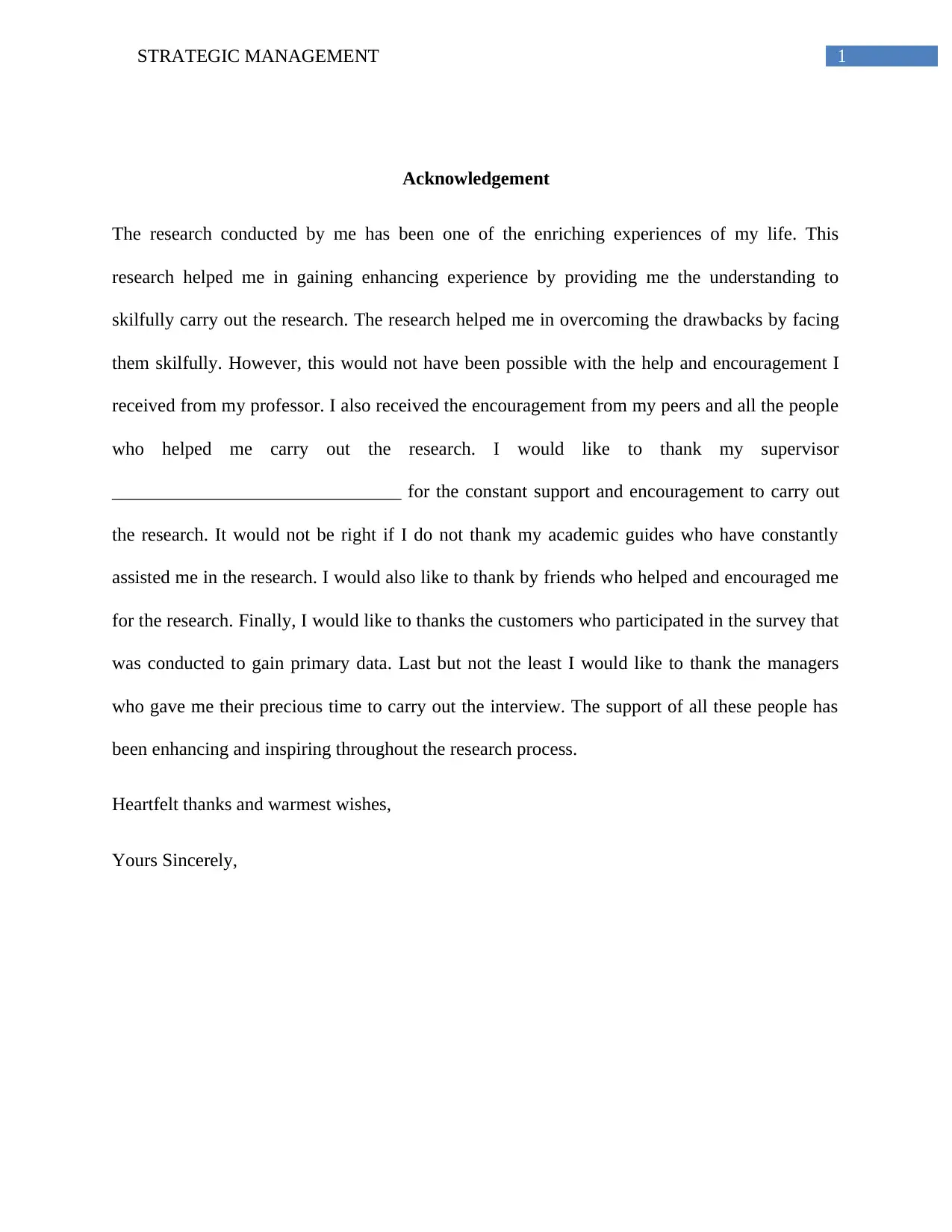
1STRATEGIC MANAGEMENT
Acknowledgement
The research conducted by me has been one of the enriching experiences of my life. This
research helped me in gaining enhancing experience by providing me the understanding to
skilfully carry out the research. The research helped me in overcoming the drawbacks by facing
them skilfully. However, this would not have been possible with the help and encouragement I
received from my professor. I also received the encouragement from my peers and all the people
who helped me carry out the research. I would like to thank my supervisor
_______________________________ for the constant support and encouragement to carry out
the research. It would not be right if I do not thank my academic guides who have constantly
assisted me in the research. I would also like to thank by friends who helped and encouraged me
for the research. Finally, I would like to thanks the customers who participated in the survey that
was conducted to gain primary data. Last but not the least I would like to thank the managers
who gave me their precious time to carry out the interview. The support of all these people has
been enhancing and inspiring throughout the research process.
Heartfelt thanks and warmest wishes,
Yours Sincerely,
Acknowledgement
The research conducted by me has been one of the enriching experiences of my life. This
research helped me in gaining enhancing experience by providing me the understanding to
skilfully carry out the research. The research helped me in overcoming the drawbacks by facing
them skilfully. However, this would not have been possible with the help and encouragement I
received from my professor. I also received the encouragement from my peers and all the people
who helped me carry out the research. I would like to thank my supervisor
_______________________________ for the constant support and encouragement to carry out
the research. It would not be right if I do not thank my academic guides who have constantly
assisted me in the research. I would also like to thank by friends who helped and encouraged me
for the research. Finally, I would like to thanks the customers who participated in the survey that
was conducted to gain primary data. Last but not the least I would like to thank the managers
who gave me their precious time to carry out the interview. The support of all these people has
been enhancing and inspiring throughout the research process.
Heartfelt thanks and warmest wishes,
Yours Sincerely,
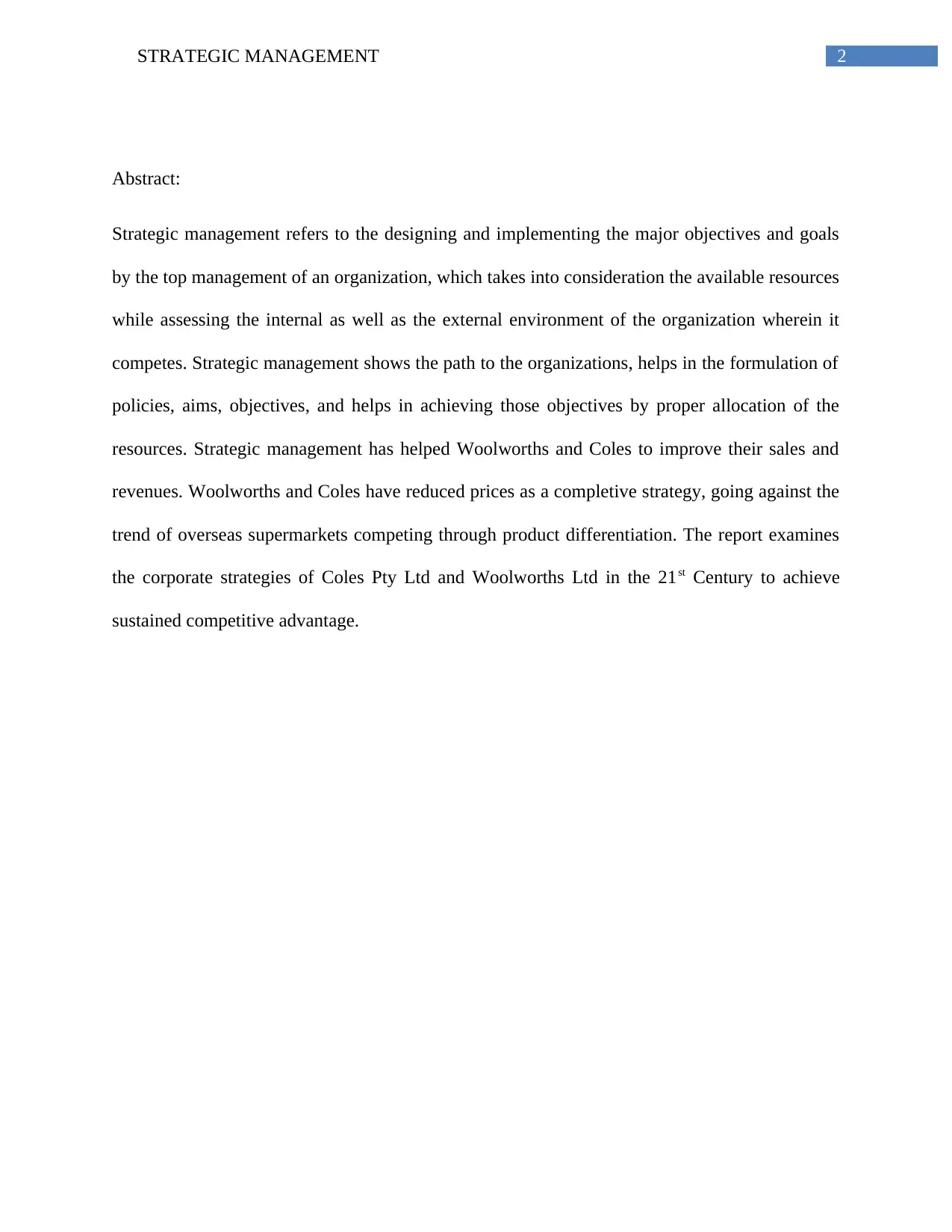
2STRATEGIC MANAGEMENT
Abstract:
Strategic management refers to the designing and implementing the major objectives and goals
by the top management of an organization, which takes into consideration the available resources
while assessing the internal as well as the external environment of the organization wherein it
competes. Strategic management shows the path to the organizations, helps in the formulation of
policies, aims, objectives, and helps in achieving those objectives by proper allocation of the
resources. Strategic management has helped Woolworths and Coles to improve their sales and
revenues. Woolworths and Coles have reduced prices as a completive strategy, going against the
trend of overseas supermarkets competing through product differentiation. The report examines
the corporate strategies of Coles Pty Ltd and Woolworths Ltd in the 21st Century to achieve
sustained competitive advantage.
Abstract:
Strategic management refers to the designing and implementing the major objectives and goals
by the top management of an organization, which takes into consideration the available resources
while assessing the internal as well as the external environment of the organization wherein it
competes. Strategic management shows the path to the organizations, helps in the formulation of
policies, aims, objectives, and helps in achieving those objectives by proper allocation of the
resources. Strategic management has helped Woolworths and Coles to improve their sales and
revenues. Woolworths and Coles have reduced prices as a completive strategy, going against the
trend of overseas supermarkets competing through product differentiation. The report examines
the corporate strategies of Coles Pty Ltd and Woolworths Ltd in the 21st Century to achieve
sustained competitive advantage.
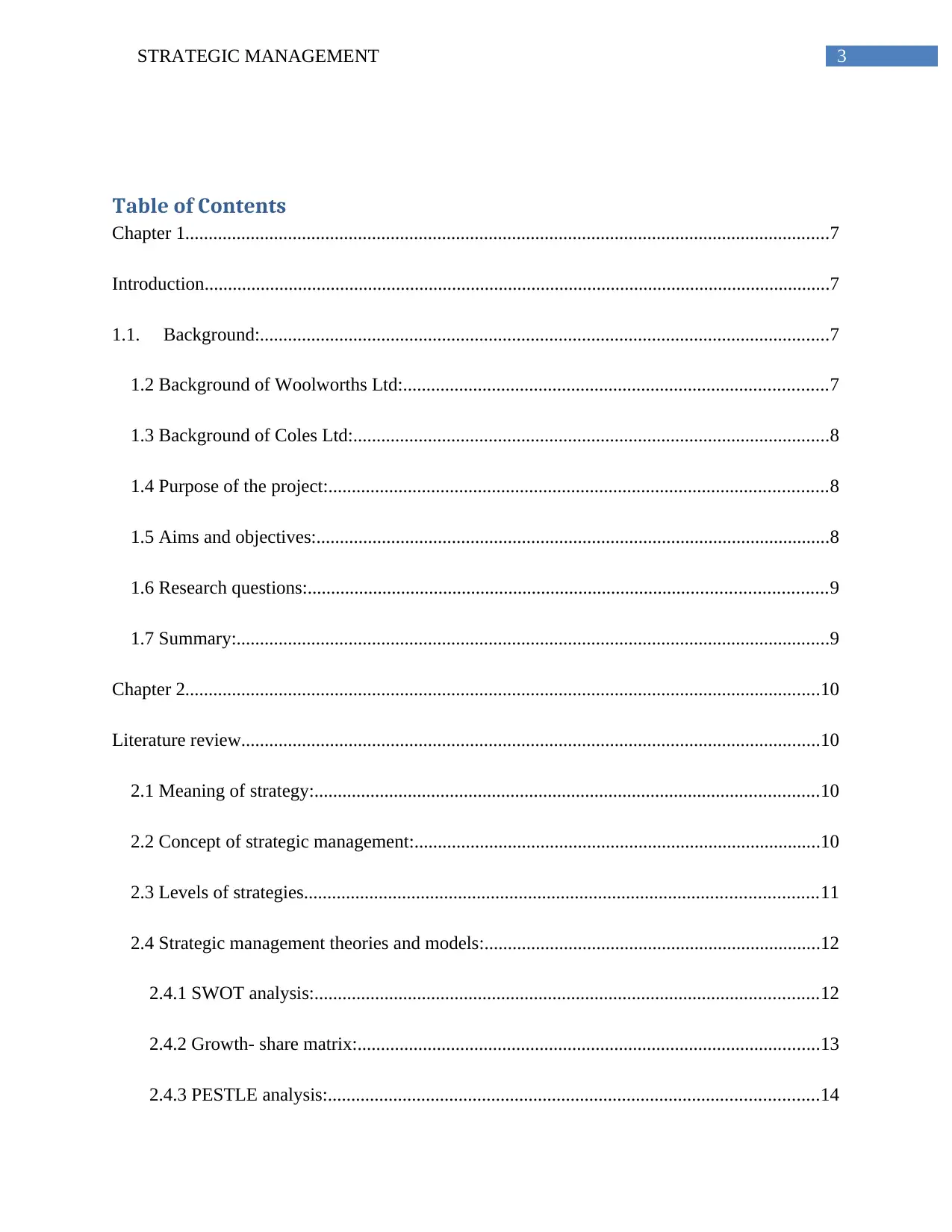
3STRATEGIC MANAGEMENT
Table of Contents
Chapter 1..........................................................................................................................................7
Introduction......................................................................................................................................7
1.1. Background:..........................................................................................................................7
1.2 Background of Woolworths Ltd:...........................................................................................7
1.3 Background of Coles Ltd:......................................................................................................8
1.4 Purpose of the project:...........................................................................................................8
1.5 Aims and objectives:..............................................................................................................8
1.6 Research questions:...............................................................................................................9
1.7 Summary:...............................................................................................................................9
Chapter 2........................................................................................................................................10
Literature review............................................................................................................................10
2.1 Meaning of strategy:............................................................................................................10
2.2 Concept of strategic management:.......................................................................................10
2.3 Levels of strategies..............................................................................................................11
2.4 Strategic management theories and models:........................................................................12
2.4.1 SWOT analysis:............................................................................................................12
2.4.2 Growth- share matrix:...................................................................................................13
2.4.3 PESTLE analysis:.........................................................................................................14
Table of Contents
Chapter 1..........................................................................................................................................7
Introduction......................................................................................................................................7
1.1. Background:..........................................................................................................................7
1.2 Background of Woolworths Ltd:...........................................................................................7
1.3 Background of Coles Ltd:......................................................................................................8
1.4 Purpose of the project:...........................................................................................................8
1.5 Aims and objectives:..............................................................................................................8
1.6 Research questions:...............................................................................................................9
1.7 Summary:...............................................................................................................................9
Chapter 2........................................................................................................................................10
Literature review............................................................................................................................10
2.1 Meaning of strategy:............................................................................................................10
2.2 Concept of strategic management:.......................................................................................10
2.3 Levels of strategies..............................................................................................................11
2.4 Strategic management theories and models:........................................................................12
2.4.1 SWOT analysis:............................................................................................................12
2.4.2 Growth- share matrix:...................................................................................................13
2.4.3 PESTLE analysis:.........................................................................................................14
Secure Best Marks with AI Grader
Need help grading? Try our AI Grader for instant feedback on your assignments.
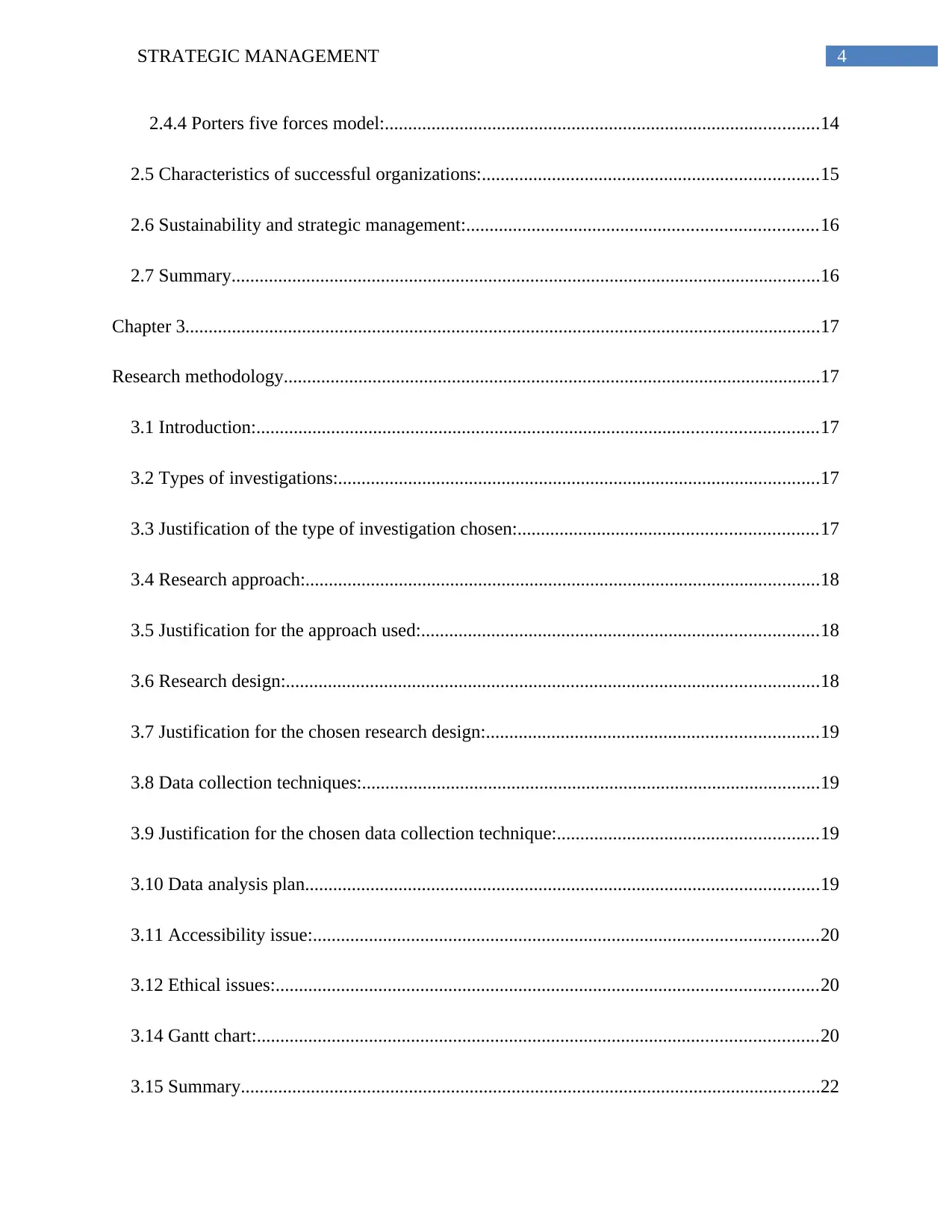
4STRATEGIC MANAGEMENT
2.4.4 Porters five forces model:.............................................................................................14
2.5 Characteristics of successful organizations:........................................................................15
2.6 Sustainability and strategic management:...........................................................................16
2.7 Summary..............................................................................................................................16
Chapter 3........................................................................................................................................17
Research methodology...................................................................................................................17
3.1 Introduction:........................................................................................................................17
3.2 Types of investigations:.......................................................................................................17
3.3 Justification of the type of investigation chosen:................................................................17
3.4 Research approach:..............................................................................................................18
3.5 Justification for the approach used:.....................................................................................18
3.6 Research design:..................................................................................................................18
3.7 Justification for the chosen research design:.......................................................................19
3.8 Data collection techniques:..................................................................................................19
3.9 Justification for the chosen data collection technique:........................................................19
3.10 Data analysis plan..............................................................................................................19
3.11 Accessibility issue:............................................................................................................20
3.12 Ethical issues:....................................................................................................................20
3.14 Gantt chart:........................................................................................................................20
3.15 Summary............................................................................................................................22
2.4.4 Porters five forces model:.............................................................................................14
2.5 Characteristics of successful organizations:........................................................................15
2.6 Sustainability and strategic management:...........................................................................16
2.7 Summary..............................................................................................................................16
Chapter 3........................................................................................................................................17
Research methodology...................................................................................................................17
3.1 Introduction:........................................................................................................................17
3.2 Types of investigations:.......................................................................................................17
3.3 Justification of the type of investigation chosen:................................................................17
3.4 Research approach:..............................................................................................................18
3.5 Justification for the approach used:.....................................................................................18
3.6 Research design:..................................................................................................................18
3.7 Justification for the chosen research design:.......................................................................19
3.8 Data collection techniques:..................................................................................................19
3.9 Justification for the chosen data collection technique:........................................................19
3.10 Data analysis plan..............................................................................................................19
3.11 Accessibility issue:............................................................................................................20
3.12 Ethical issues:....................................................................................................................20
3.14 Gantt chart:........................................................................................................................20
3.15 Summary............................................................................................................................22
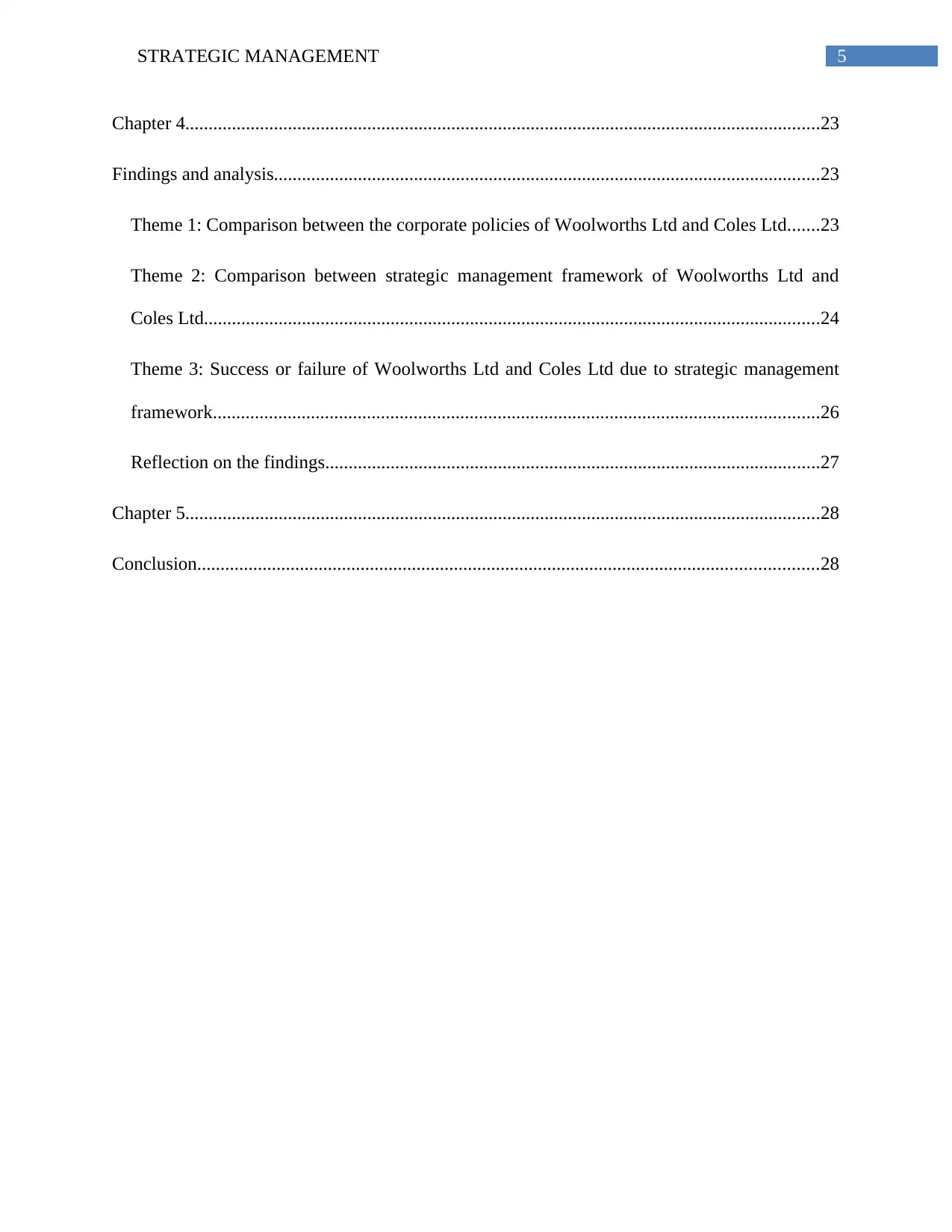
5STRATEGIC MANAGEMENT
Chapter 4........................................................................................................................................23
Findings and analysis.....................................................................................................................23
Theme 1: Comparison between the corporate policies of Woolworths Ltd and Coles Ltd.......23
Theme 2: Comparison between strategic management framework of Woolworths Ltd and
Coles Ltd....................................................................................................................................24
Theme 3: Success or failure of Woolworths Ltd and Coles Ltd due to strategic management
framework..................................................................................................................................26
Reflection on the findings..........................................................................................................27
Chapter 5........................................................................................................................................28
Conclusion.....................................................................................................................................28
Chapter 4........................................................................................................................................23
Findings and analysis.....................................................................................................................23
Theme 1: Comparison between the corporate policies of Woolworths Ltd and Coles Ltd.......23
Theme 2: Comparison between strategic management framework of Woolworths Ltd and
Coles Ltd....................................................................................................................................24
Theme 3: Success or failure of Woolworths Ltd and Coles Ltd due to strategic management
framework..................................................................................................................................26
Reflection on the findings..........................................................................................................27
Chapter 5........................................................................................................................................28
Conclusion.....................................................................................................................................28
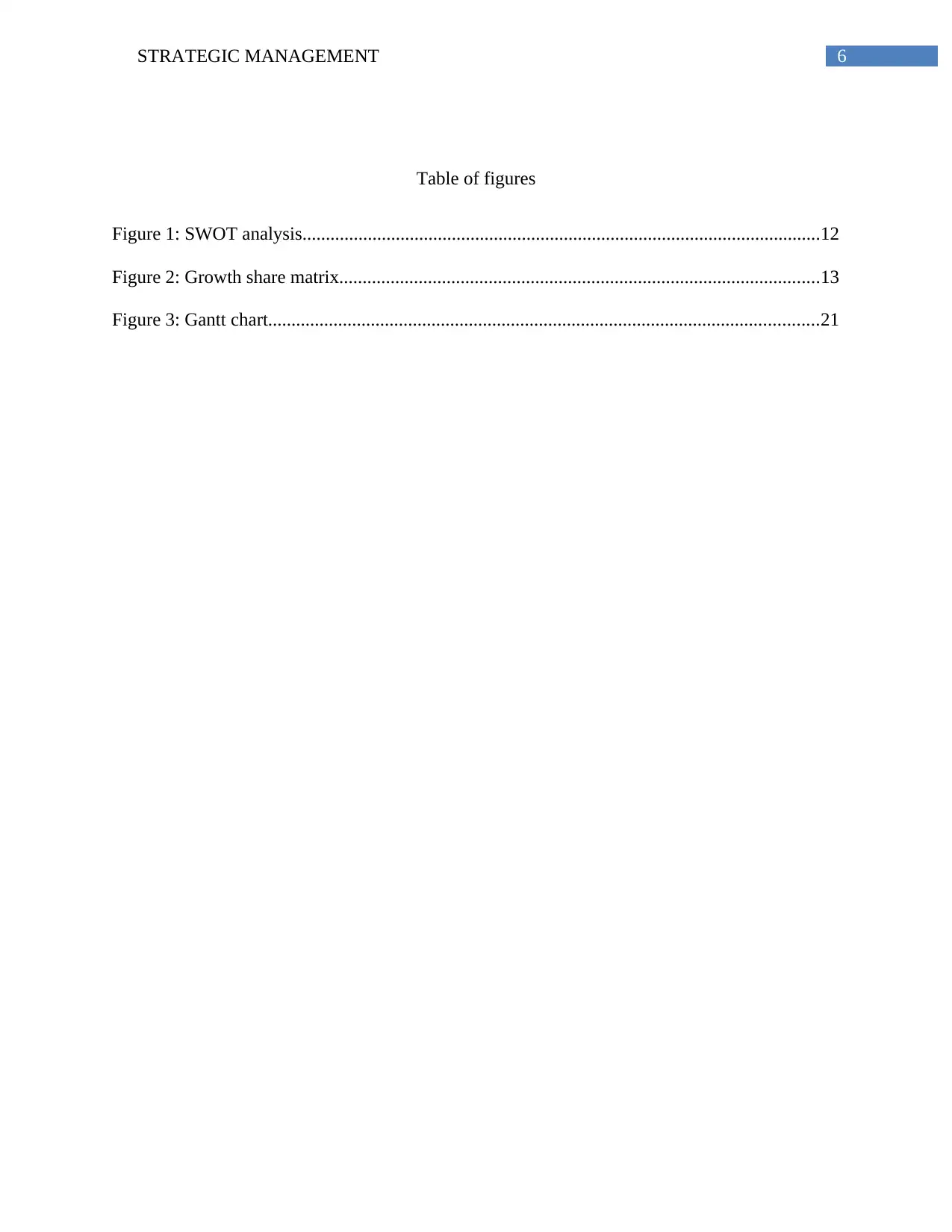
6STRATEGIC MANAGEMENT
Table of figures
Figure 1: SWOT analysis...............................................................................................................12
Figure 2: Growth share matrix.......................................................................................................13
Figure 3: Gantt chart......................................................................................................................21
Table of figures
Figure 1: SWOT analysis...............................................................................................................12
Figure 2: Growth share matrix.......................................................................................................13
Figure 3: Gantt chart......................................................................................................................21
Paraphrase This Document
Need a fresh take? Get an instant paraphrase of this document with our AI Paraphraser
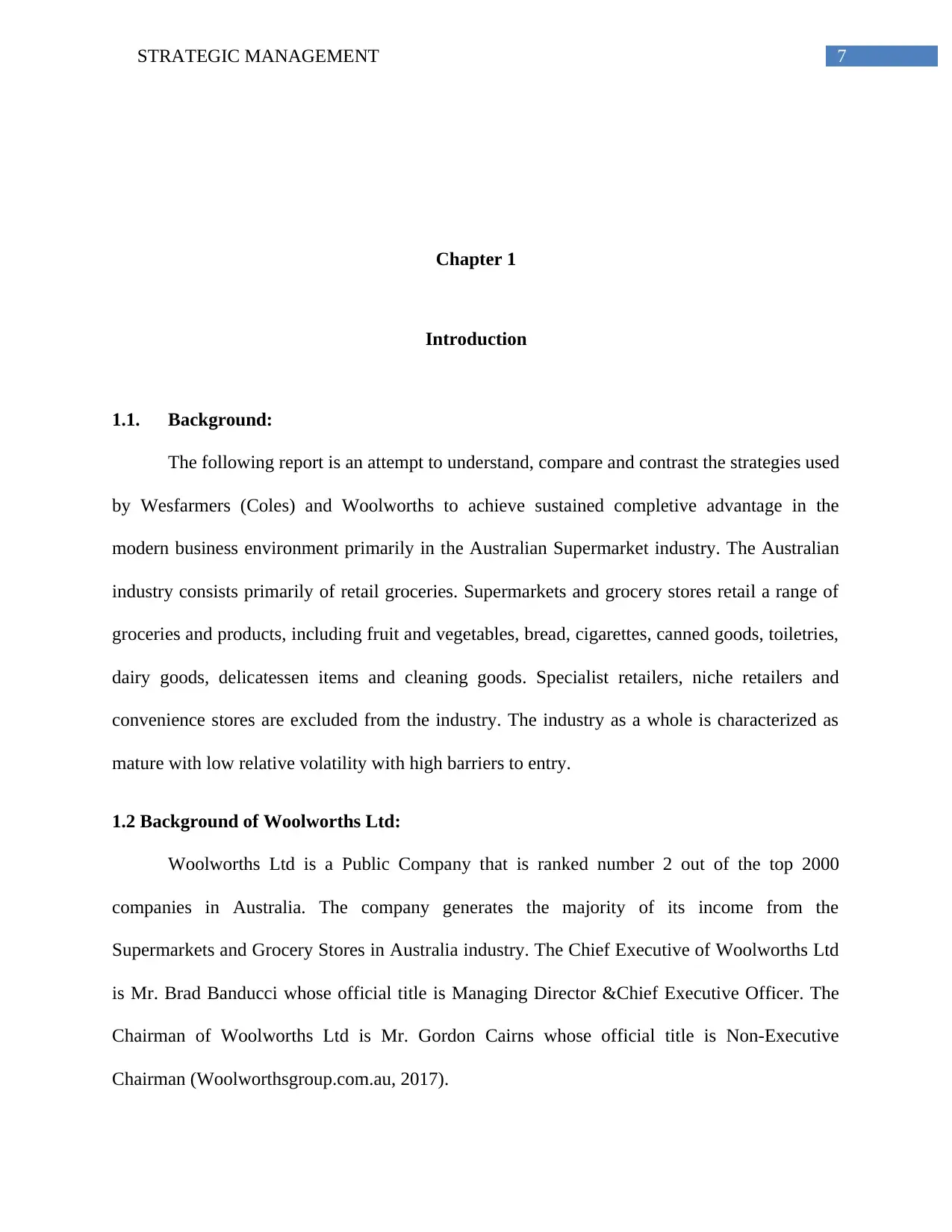
7STRATEGIC MANAGEMENT
Chapter 1
Introduction
1.1. Background:
The following report is an attempt to understand, compare and contrast the strategies used
by Wesfarmers (Coles) and Woolworths to achieve sustained completive advantage in the
modern business environment primarily in the Australian Supermarket industry. The Australian
industry consists primarily of retail groceries. Supermarkets and grocery stores retail a range of
groceries and products, including fruit and vegetables, bread, cigarettes, canned goods, toiletries,
dairy goods, delicatessen items and cleaning goods. Specialist retailers, niche retailers and
convenience stores are excluded from the industry. The industry as a whole is characterized as
mature with low relative volatility with high barriers to entry.
1.2 Background of Woolworths Ltd:
Woolworths Ltd is a Public Company that is ranked number 2 out of the top 2000
companies in Australia. The company generates the majority of its income from the
Supermarkets and Grocery Stores in Australia industry. The Chief Executive of Woolworths Ltd
is Mr. Brad Banducci whose official title is Managing Director &Chief Executive Officer. The
Chairman of Woolworths Ltd is Mr. Gordon Cairns whose official title is Non-Executive
Chairman (Woolworthsgroup.com.au, 2017).
Chapter 1
Introduction
1.1. Background:
The following report is an attempt to understand, compare and contrast the strategies used
by Wesfarmers (Coles) and Woolworths to achieve sustained completive advantage in the
modern business environment primarily in the Australian Supermarket industry. The Australian
industry consists primarily of retail groceries. Supermarkets and grocery stores retail a range of
groceries and products, including fruit and vegetables, bread, cigarettes, canned goods, toiletries,
dairy goods, delicatessen items and cleaning goods. Specialist retailers, niche retailers and
convenience stores are excluded from the industry. The industry as a whole is characterized as
mature with low relative volatility with high barriers to entry.
1.2 Background of Woolworths Ltd:
Woolworths Ltd is a Public Company that is ranked number 2 out of the top 2000
companies in Australia. The company generates the majority of its income from the
Supermarkets and Grocery Stores in Australia industry. The Chief Executive of Woolworths Ltd
is Mr. Brad Banducci whose official title is Managing Director &Chief Executive Officer. The
Chairman of Woolworths Ltd is Mr. Gordon Cairns whose official title is Non-Executive
Chairman (Woolworthsgroup.com.au, 2017).
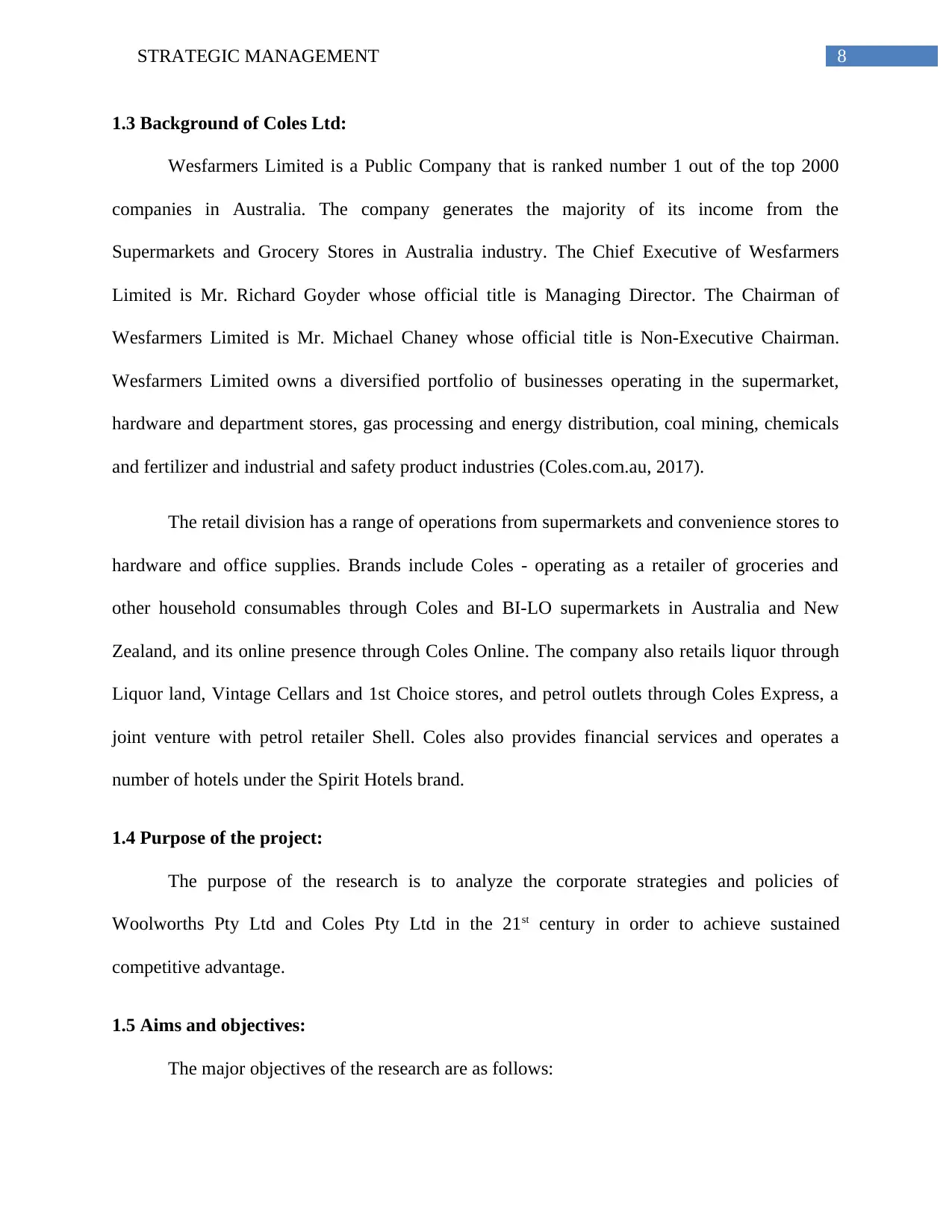
8STRATEGIC MANAGEMENT
1.3 Background of Coles Ltd:
Wesfarmers Limited is a Public Company that is ranked number 1 out of the top 2000
companies in Australia. The company generates the majority of its income from the
Supermarkets and Grocery Stores in Australia industry. The Chief Executive of Wesfarmers
Limited is Mr. Richard Goyder whose official title is Managing Director. The Chairman of
Wesfarmers Limited is Mr. Michael Chaney whose official title is Non-Executive Chairman.
Wesfarmers Limited owns a diversified portfolio of businesses operating in the supermarket,
hardware and department stores, gas processing and energy distribution, coal mining, chemicals
and fertilizer and industrial and safety product industries (Coles.com.au, 2017).
The retail division has a range of operations from supermarkets and convenience stores to
hardware and office supplies. Brands include Coles - operating as a retailer of groceries and
other household consumables through Coles and BI-LO supermarkets in Australia and New
Zealand, and its online presence through Coles Online. The company also retails liquor through
Liquor land, Vintage Cellars and 1st Choice stores, and petrol outlets through Coles Express, a
joint venture with petrol retailer Shell. Coles also provides financial services and operates a
number of hotels under the Spirit Hotels brand.
1.4 Purpose of the project:
The purpose of the research is to analyze the corporate strategies and policies of
Woolworths Pty Ltd and Coles Pty Ltd in the 21st century in order to achieve sustained
competitive advantage.
1.5 Aims and objectives:
The major objectives of the research are as follows:
1.3 Background of Coles Ltd:
Wesfarmers Limited is a Public Company that is ranked number 1 out of the top 2000
companies in Australia. The company generates the majority of its income from the
Supermarkets and Grocery Stores in Australia industry. The Chief Executive of Wesfarmers
Limited is Mr. Richard Goyder whose official title is Managing Director. The Chairman of
Wesfarmers Limited is Mr. Michael Chaney whose official title is Non-Executive Chairman.
Wesfarmers Limited owns a diversified portfolio of businesses operating in the supermarket,
hardware and department stores, gas processing and energy distribution, coal mining, chemicals
and fertilizer and industrial and safety product industries (Coles.com.au, 2017).
The retail division has a range of operations from supermarkets and convenience stores to
hardware and office supplies. Brands include Coles - operating as a retailer of groceries and
other household consumables through Coles and BI-LO supermarkets in Australia and New
Zealand, and its online presence through Coles Online. The company also retails liquor through
Liquor land, Vintage Cellars and 1st Choice stores, and petrol outlets through Coles Express, a
joint venture with petrol retailer Shell. Coles also provides financial services and operates a
number of hotels under the Spirit Hotels brand.
1.4 Purpose of the project:
The purpose of the research is to analyze the corporate strategies and policies of
Woolworths Pty Ltd and Coles Pty Ltd in the 21st century in order to achieve sustained
competitive advantage.
1.5 Aims and objectives:
The major objectives of the research are as follows:
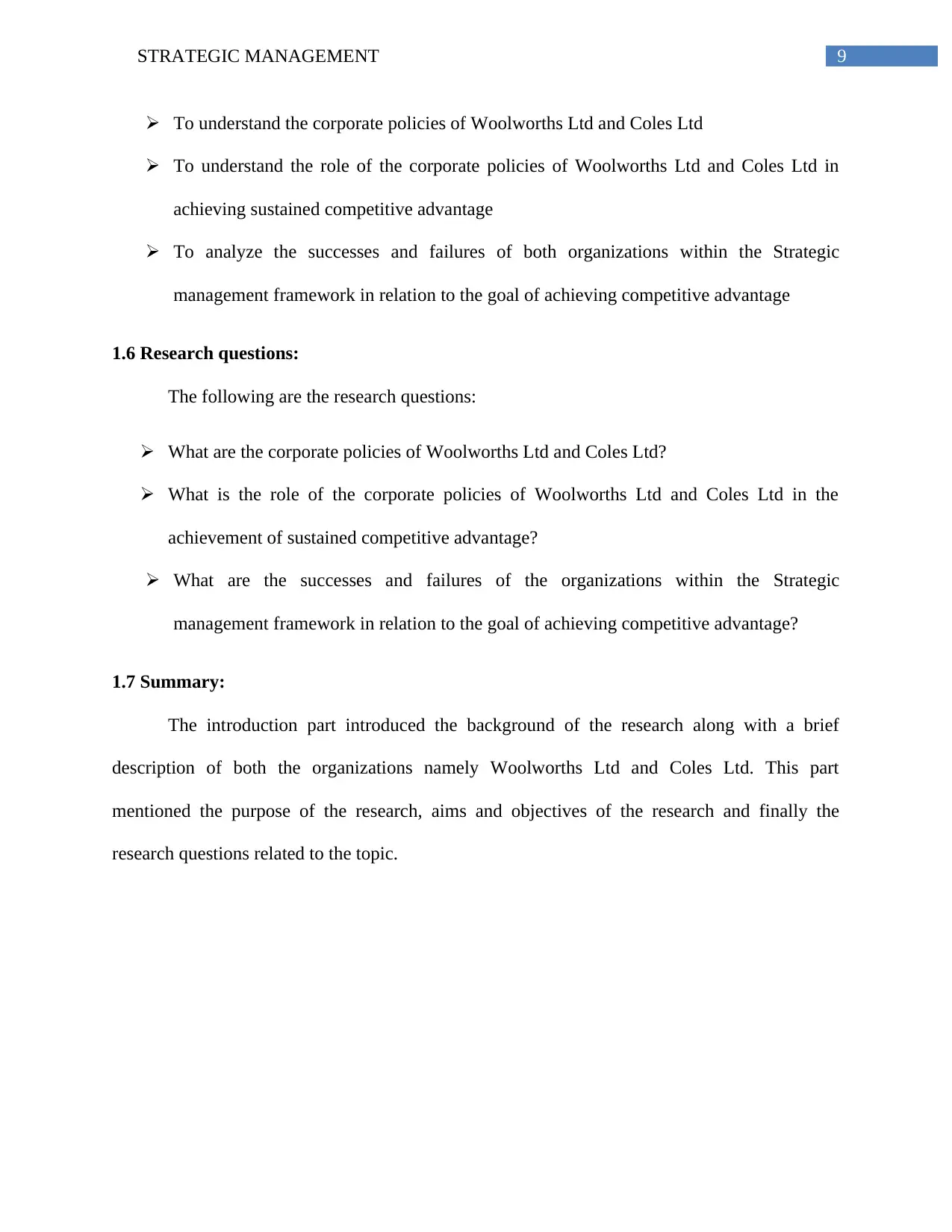
9STRATEGIC MANAGEMENT
To understand the corporate policies of Woolworths Ltd and Coles Ltd
To understand the role of the corporate policies of Woolworths Ltd and Coles Ltd in
achieving sustained competitive advantage
To analyze the successes and failures of both organizations within the Strategic
management framework in relation to the goal of achieving competitive advantage
1.6 Research questions:
The following are the research questions:
What are the corporate policies of Woolworths Ltd and Coles Ltd?
What is the role of the corporate policies of Woolworths Ltd and Coles Ltd in the
achievement of sustained competitive advantage?
What are the successes and failures of the organizations within the Strategic
management framework in relation to the goal of achieving competitive advantage?
1.7 Summary:
The introduction part introduced the background of the research along with a brief
description of both the organizations namely Woolworths Ltd and Coles Ltd. This part
mentioned the purpose of the research, aims and objectives of the research and finally the
research questions related to the topic.
To understand the corporate policies of Woolworths Ltd and Coles Ltd
To understand the role of the corporate policies of Woolworths Ltd and Coles Ltd in
achieving sustained competitive advantage
To analyze the successes and failures of both organizations within the Strategic
management framework in relation to the goal of achieving competitive advantage
1.6 Research questions:
The following are the research questions:
What are the corporate policies of Woolworths Ltd and Coles Ltd?
What is the role of the corporate policies of Woolworths Ltd and Coles Ltd in the
achievement of sustained competitive advantage?
What are the successes and failures of the organizations within the Strategic
management framework in relation to the goal of achieving competitive advantage?
1.7 Summary:
The introduction part introduced the background of the research along with a brief
description of both the organizations namely Woolworths Ltd and Coles Ltd. This part
mentioned the purpose of the research, aims and objectives of the research and finally the
research questions related to the topic.
Secure Best Marks with AI Grader
Need help grading? Try our AI Grader for instant feedback on your assignments.

10STRATEGIC MANAGEMENT
Chapter 2
Literature review
2.1 Meaning of strategy:
According to Rothaermel (2015), strategy refers to the plan of action that is designed in
order to accomplish a specific goal or objective. The concept of strategy was earlier used by the
military forces and was later on borrowed by the business organizations in order to bridge or
lower the gap between the policies of an organization and the tactics. Strategy is defined as the
basic decisions, aims, objectives and mission of an organization that are decided by the top level
managers.
2.2 Concept of strategic management:
According to Hill and Jones (2014), strategic management refers to the designing and
implementing the major objectives and goals by the top management of an organization, which
takes into consideration the available resources while assessing the internal as well as the
external environment of the organization wherein it competes. Strategic management shows the
path to the organizations, helps in the formulation of policies, aims, objectives, and helps in
achieving those objectives by proper allocation of the resources. Strategic management is the
procedure through which an organization forms its objectives and the the ways in which the
management achieves those objectives. The proper coordination between the objectives of an
organization and the strategies determine the effectiveness of the management. Strategic
management integrates the various functions within an organization into a whole. These
strategies enable an organization to achieve its high-level goals and assist the lower level
Chapter 2
Literature review
2.1 Meaning of strategy:
According to Rothaermel (2015), strategy refers to the plan of action that is designed in
order to accomplish a specific goal or objective. The concept of strategy was earlier used by the
military forces and was later on borrowed by the business organizations in order to bridge or
lower the gap between the policies of an organization and the tactics. Strategy is defined as the
basic decisions, aims, objectives and mission of an organization that are decided by the top level
managers.
2.2 Concept of strategic management:
According to Hill and Jones (2014), strategic management refers to the designing and
implementing the major objectives and goals by the top management of an organization, which
takes into consideration the available resources while assessing the internal as well as the
external environment of the organization wherein it competes. Strategic management shows the
path to the organizations, helps in the formulation of policies, aims, objectives, and helps in
achieving those objectives by proper allocation of the resources. Strategic management is the
procedure through which an organization forms its objectives and the the ways in which the
management achieves those objectives. The proper coordination between the objectives of an
organization and the strategies determine the effectiveness of the management. Strategic
management integrates the various functions within an organization into a whole. These
strategies enable an organization to achieve its high-level goals and assist the lower level
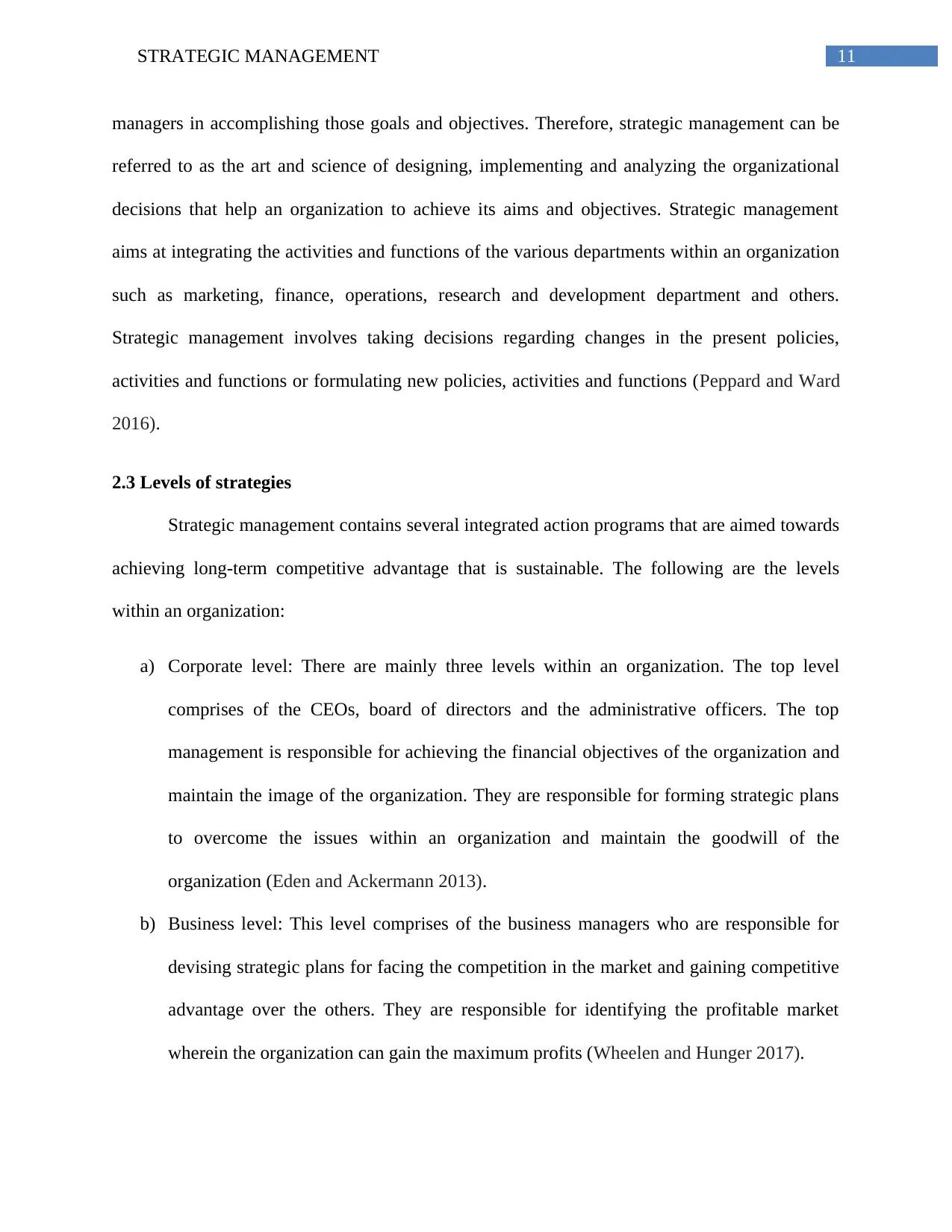
11STRATEGIC MANAGEMENT
managers in accomplishing those goals and objectives. Therefore, strategic management can be
referred to as the art and science of designing, implementing and analyzing the organizational
decisions that help an organization to achieve its aims and objectives. Strategic management
aims at integrating the activities and functions of the various departments within an organization
such as marketing, finance, operations, research and development department and others.
Strategic management involves taking decisions regarding changes in the present policies,
activities and functions or formulating new policies, activities and functions (Peppard and Ward
2016).
2.3 Levels of strategies
Strategic management contains several integrated action programs that are aimed towards
achieving long-term competitive advantage that is sustainable. The following are the levels
within an organization:
a) Corporate level: There are mainly three levels within an organization. The top level
comprises of the CEOs, board of directors and the administrative officers. The top
management is responsible for achieving the financial objectives of the organization and
maintain the image of the organization. They are responsible for forming strategic plans
to overcome the issues within an organization and maintain the goodwill of the
organization (Eden and Ackermann 2013).
b) Business level: This level comprises of the business managers who are responsible for
devising strategic plans for facing the competition in the market and gaining competitive
advantage over the others. They are responsible for identifying the profitable market
wherein the organization can gain the maximum profits (Wheelen and Hunger 2017).
managers in accomplishing those goals and objectives. Therefore, strategic management can be
referred to as the art and science of designing, implementing and analyzing the organizational
decisions that help an organization to achieve its aims and objectives. Strategic management
aims at integrating the activities and functions of the various departments within an organization
such as marketing, finance, operations, research and development department and others.
Strategic management involves taking decisions regarding changes in the present policies,
activities and functions or formulating new policies, activities and functions (Peppard and Ward
2016).
2.3 Levels of strategies
Strategic management contains several integrated action programs that are aimed towards
achieving long-term competitive advantage that is sustainable. The following are the levels
within an organization:
a) Corporate level: There are mainly three levels within an organization. The top level
comprises of the CEOs, board of directors and the administrative officers. The top
management is responsible for achieving the financial objectives of the organization and
maintain the image of the organization. They are responsible for forming strategic plans
to overcome the issues within an organization and maintain the goodwill of the
organization (Eden and Ackermann 2013).
b) Business level: This level comprises of the business managers who are responsible for
devising strategic plans for facing the competition in the market and gaining competitive
advantage over the others. They are responsible for identifying the profitable market
wherein the organization can gain the maximum profits (Wheelen and Hunger 2017).
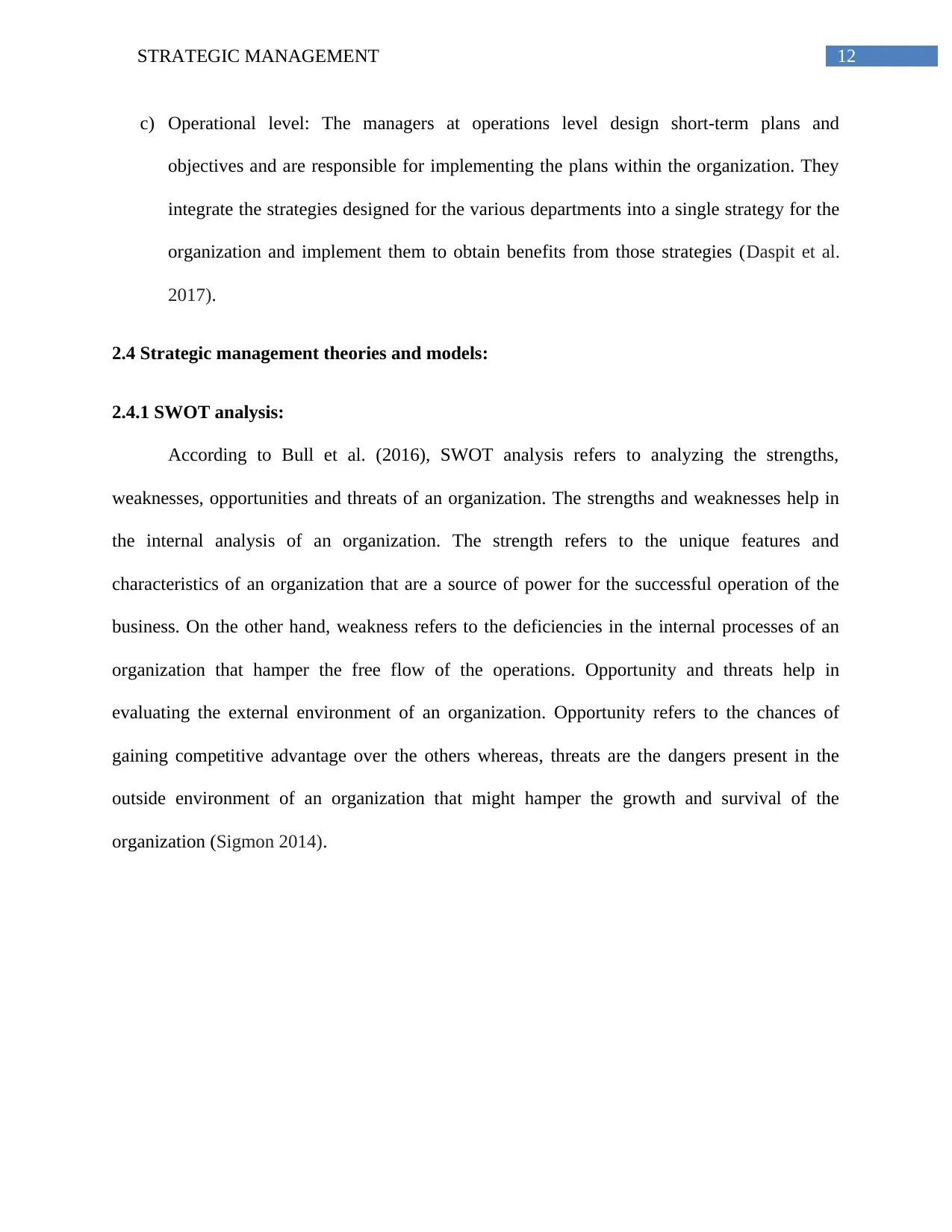
12STRATEGIC MANAGEMENT
c) Operational level: The managers at operations level design short-term plans and
objectives and are responsible for implementing the plans within the organization. They
integrate the strategies designed for the various departments into a single strategy for the
organization and implement them to obtain benefits from those strategies (Daspit et al.
2017).
2.4 Strategic management theories and models:
2.4.1 SWOT analysis:
According to Bull et al. (2016), SWOT analysis refers to analyzing the strengths,
weaknesses, opportunities and threats of an organization. The strengths and weaknesses help in
the internal analysis of an organization. The strength refers to the unique features and
characteristics of an organization that are a source of power for the successful operation of the
business. On the other hand, weakness refers to the deficiencies in the internal processes of an
organization that hamper the free flow of the operations. Opportunity and threats help in
evaluating the external environment of an organization. Opportunity refers to the chances of
gaining competitive advantage over the others whereas, threats are the dangers present in the
outside environment of an organization that might hamper the growth and survival of the
organization (Sigmon 2014).
c) Operational level: The managers at operations level design short-term plans and
objectives and are responsible for implementing the plans within the organization. They
integrate the strategies designed for the various departments into a single strategy for the
organization and implement them to obtain benefits from those strategies (Daspit et al.
2017).
2.4 Strategic management theories and models:
2.4.1 SWOT analysis:
According to Bull et al. (2016), SWOT analysis refers to analyzing the strengths,
weaknesses, opportunities and threats of an organization. The strengths and weaknesses help in
the internal analysis of an organization. The strength refers to the unique features and
characteristics of an organization that are a source of power for the successful operation of the
business. On the other hand, weakness refers to the deficiencies in the internal processes of an
organization that hamper the free flow of the operations. Opportunity and threats help in
evaluating the external environment of an organization. Opportunity refers to the chances of
gaining competitive advantage over the others whereas, threats are the dangers present in the
outside environment of an organization that might hamper the growth and survival of the
organization (Sigmon 2014).
Paraphrase This Document
Need a fresh take? Get an instant paraphrase of this document with our AI Paraphraser
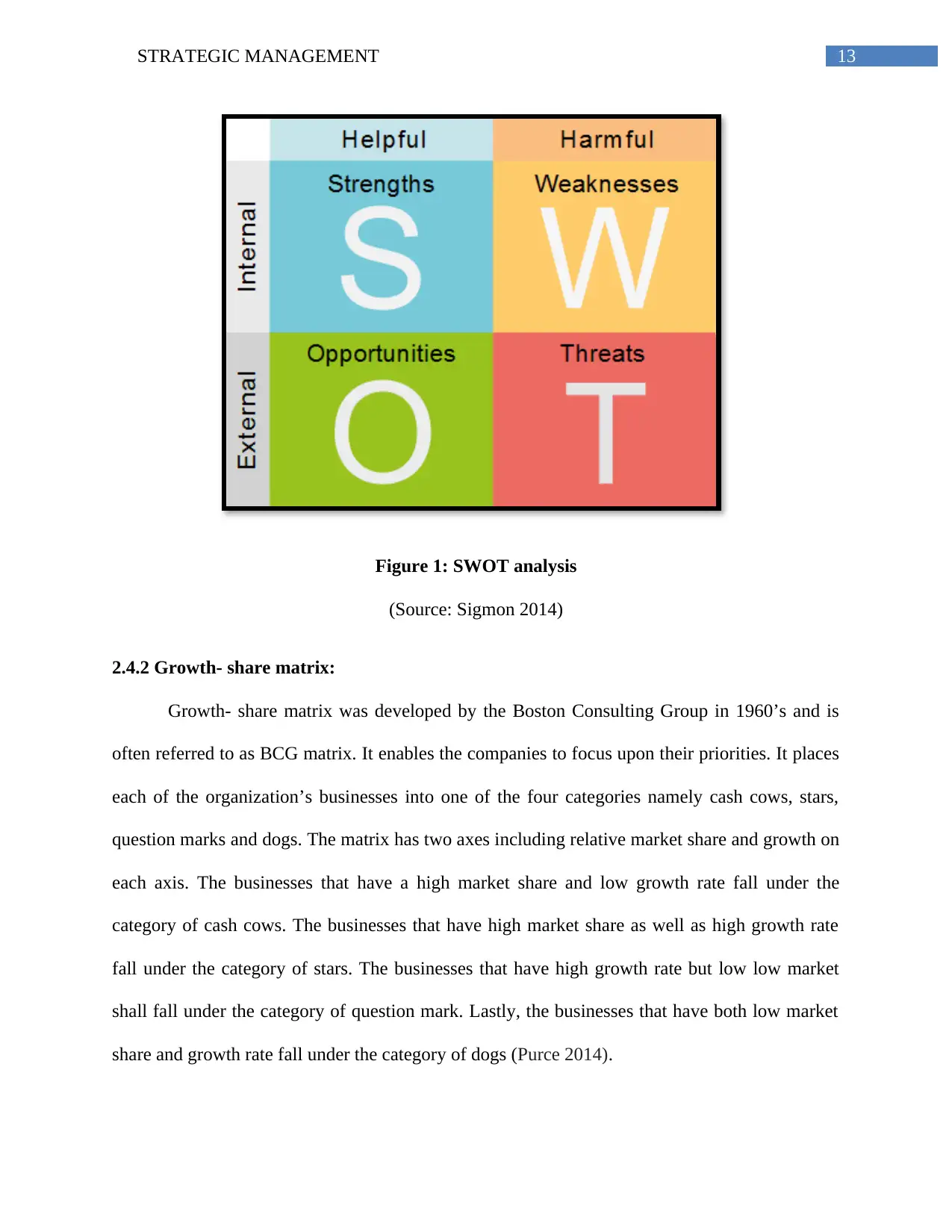
13STRATEGIC MANAGEMENT
Figure 1: SWOT analysis
(Source: Sigmon 2014)
2.4.2 Growth- share matrix:
Growth- share matrix was developed by the Boston Consulting Group in 1960’s and is
often referred to as BCG matrix. It enables the companies to focus upon their priorities. It places
each of the organization’s businesses into one of the four categories namely cash cows, stars,
question marks and dogs. The matrix has two axes including relative market share and growth on
each axis. The businesses that have a high market share and low growth rate fall under the
category of cash cows. The businesses that have high market share as well as high growth rate
fall under the category of stars. The businesses that have high growth rate but low low market
shall fall under the category of question mark. Lastly, the businesses that have both low market
share and growth rate fall under the category of dogs (Purce 2014).
Figure 1: SWOT analysis
(Source: Sigmon 2014)
2.4.2 Growth- share matrix:
Growth- share matrix was developed by the Boston Consulting Group in 1960’s and is
often referred to as BCG matrix. It enables the companies to focus upon their priorities. It places
each of the organization’s businesses into one of the four categories namely cash cows, stars,
question marks and dogs. The matrix has two axes including relative market share and growth on
each axis. The businesses that have a high market share and low growth rate fall under the
category of cash cows. The businesses that have high market share as well as high growth rate
fall under the category of stars. The businesses that have high growth rate but low low market
shall fall under the category of question mark. Lastly, the businesses that have both low market
share and growth rate fall under the category of dogs (Purce 2014).
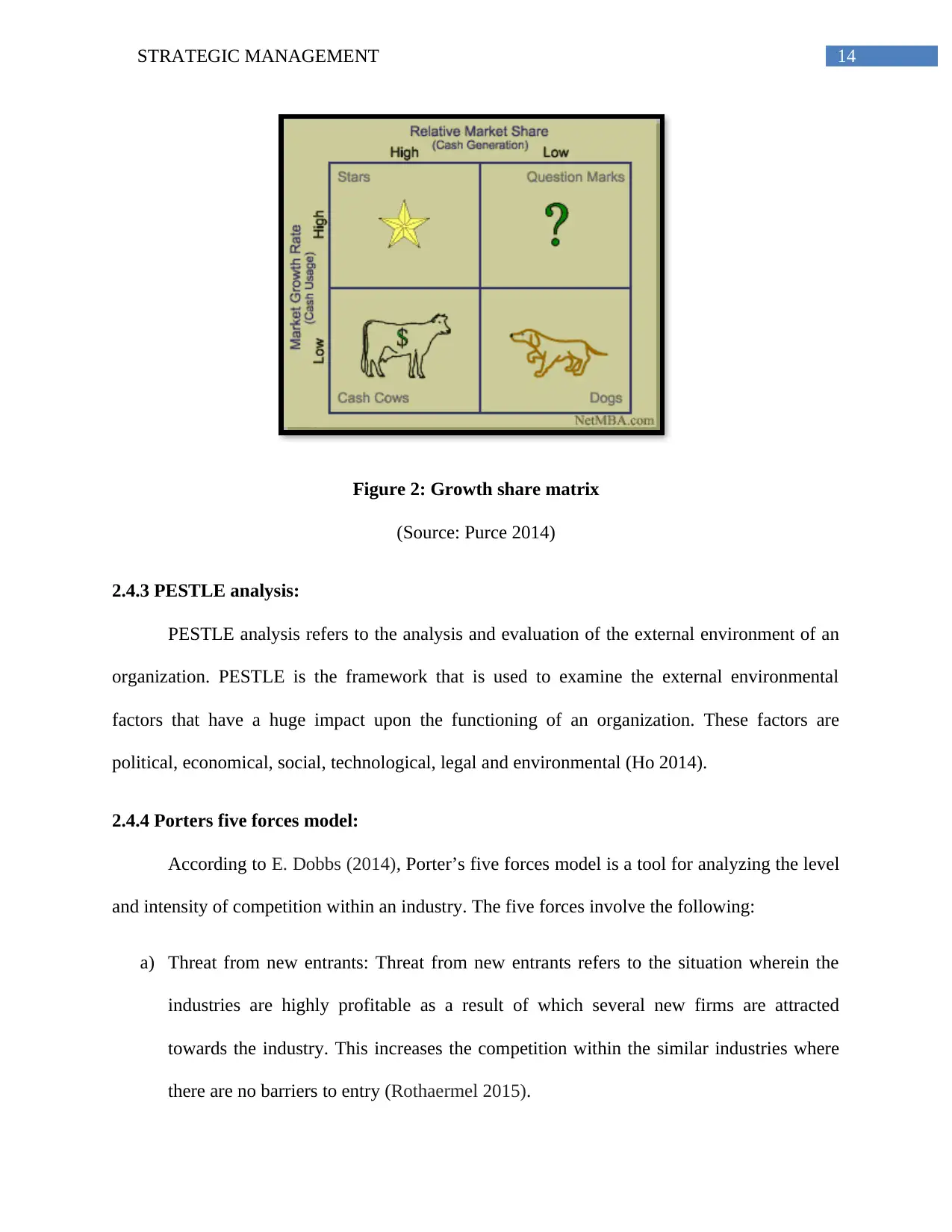
14STRATEGIC MANAGEMENT
Figure 2: Growth share matrix
(Source: Purce 2014)
2.4.3 PESTLE analysis:
PESTLE analysis refers to the analysis and evaluation of the external environment of an
organization. PESTLE is the framework that is used to examine the external environmental
factors that have a huge impact upon the functioning of an organization. These factors are
political, economical, social, technological, legal and environmental (Ho 2014).
2.4.4 Porters five forces model:
According to E. Dobbs (2014), Porter’s five forces model is a tool for analyzing the level
and intensity of competition within an industry. The five forces involve the following:
a) Threat from new entrants: Threat from new entrants refers to the situation wherein the
industries are highly profitable as a result of which several new firms are attracted
towards the industry. This increases the competition within the similar industries where
there are no barriers to entry (Rothaermel 2015).
Figure 2: Growth share matrix
(Source: Purce 2014)
2.4.3 PESTLE analysis:
PESTLE analysis refers to the analysis and evaluation of the external environment of an
organization. PESTLE is the framework that is used to examine the external environmental
factors that have a huge impact upon the functioning of an organization. These factors are
political, economical, social, technological, legal and environmental (Ho 2014).
2.4.4 Porters five forces model:
According to E. Dobbs (2014), Porter’s five forces model is a tool for analyzing the level
and intensity of competition within an industry. The five forces involve the following:
a) Threat from new entrants: Threat from new entrants refers to the situation wherein the
industries are highly profitable as a result of which several new firms are attracted
towards the industry. This increases the competition within the similar industries where
there are no barriers to entry (Rothaermel 2015).
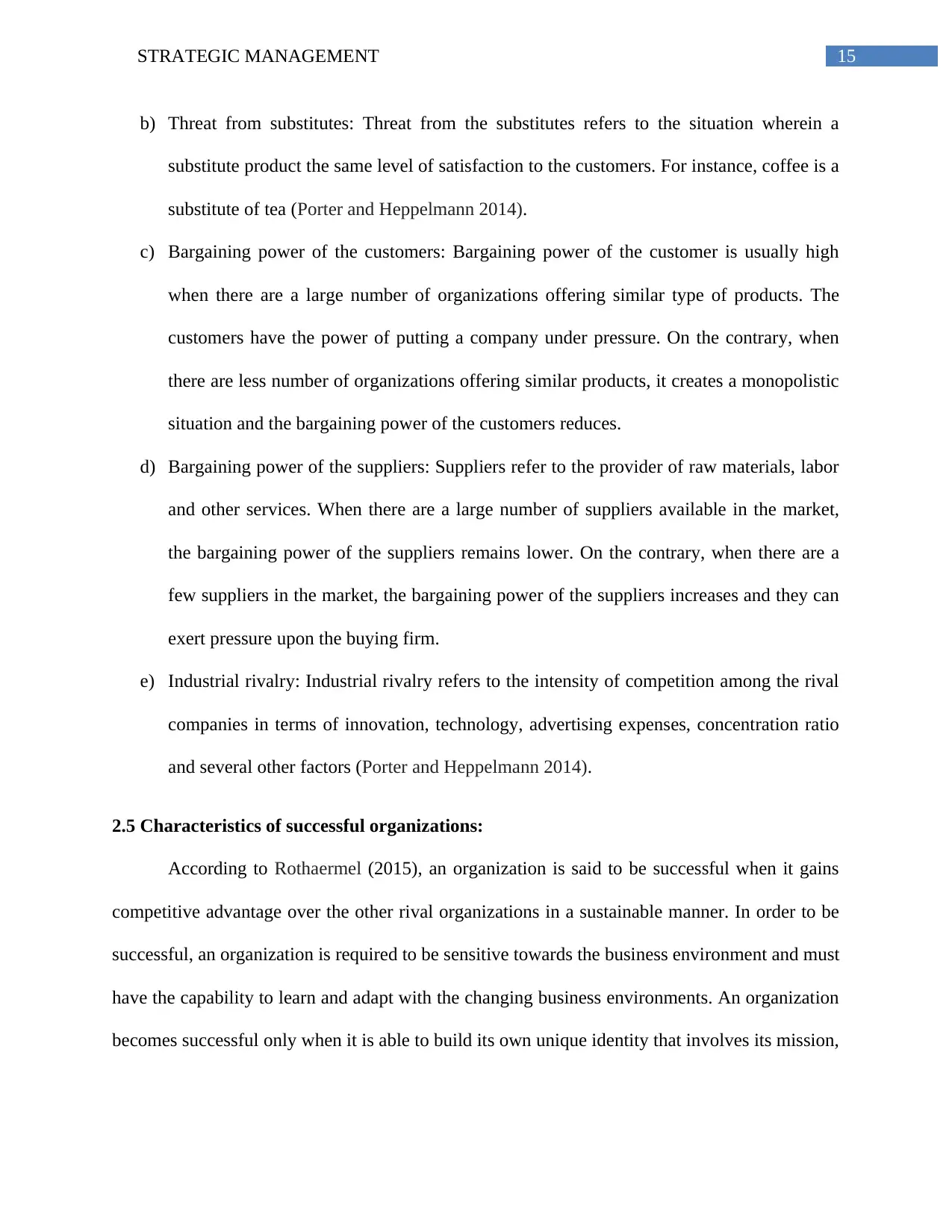
15STRATEGIC MANAGEMENT
b) Threat from substitutes: Threat from the substitutes refers to the situation wherein a
substitute product the same level of satisfaction to the customers. For instance, coffee is a
substitute of tea (Porter and Heppelmann 2014).
c) Bargaining power of the customers: Bargaining power of the customer is usually high
when there are a large number of organizations offering similar type of products. The
customers have the power of putting a company under pressure. On the contrary, when
there are less number of organizations offering similar products, it creates a monopolistic
situation and the bargaining power of the customers reduces.
d) Bargaining power of the suppliers: Suppliers refer to the provider of raw materials, labor
and other services. When there are a large number of suppliers available in the market,
the bargaining power of the suppliers remains lower. On the contrary, when there are a
few suppliers in the market, the bargaining power of the suppliers increases and they can
exert pressure upon the buying firm.
e) Industrial rivalry: Industrial rivalry refers to the intensity of competition among the rival
companies in terms of innovation, technology, advertising expenses, concentration ratio
and several other factors (Porter and Heppelmann 2014).
2.5 Characteristics of successful organizations:
According to Rothaermel (2015), an organization is said to be successful when it gains
competitive advantage over the other rival organizations in a sustainable manner. In order to be
successful, an organization is required to be sensitive towards the business environment and must
have the capability to learn and adapt with the changing business environments. An organization
becomes successful only when it is able to build its own unique identity that involves its mission,
b) Threat from substitutes: Threat from the substitutes refers to the situation wherein a
substitute product the same level of satisfaction to the customers. For instance, coffee is a
substitute of tea (Porter and Heppelmann 2014).
c) Bargaining power of the customers: Bargaining power of the customer is usually high
when there are a large number of organizations offering similar type of products. The
customers have the power of putting a company under pressure. On the contrary, when
there are less number of organizations offering similar products, it creates a monopolistic
situation and the bargaining power of the customers reduces.
d) Bargaining power of the suppliers: Suppliers refer to the provider of raw materials, labor
and other services. When there are a large number of suppliers available in the market,
the bargaining power of the suppliers remains lower. On the contrary, when there are a
few suppliers in the market, the bargaining power of the suppliers increases and they can
exert pressure upon the buying firm.
e) Industrial rivalry: Industrial rivalry refers to the intensity of competition among the rival
companies in terms of innovation, technology, advertising expenses, concentration ratio
and several other factors (Porter and Heppelmann 2014).
2.5 Characteristics of successful organizations:
According to Rothaermel (2015), an organization is said to be successful when it gains
competitive advantage over the other rival organizations in a sustainable manner. In order to be
successful, an organization is required to be sensitive towards the business environment and must
have the capability to learn and adapt with the changing business environments. An organization
becomes successful only when it is able to build its own unique identity that involves its mission,
Secure Best Marks with AI Grader
Need help grading? Try our AI Grader for instant feedback on your assignments.
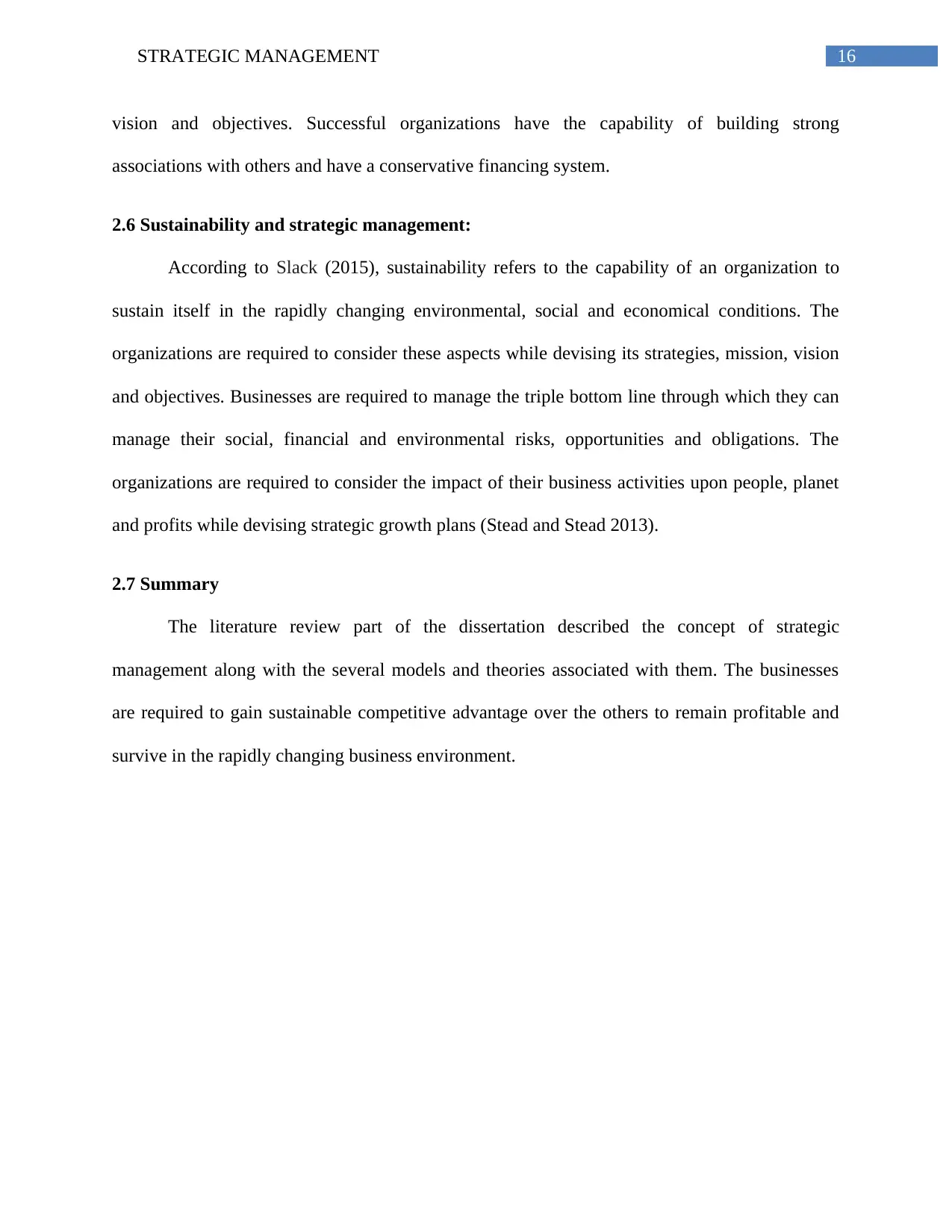
16STRATEGIC MANAGEMENT
vision and objectives. Successful organizations have the capability of building strong
associations with others and have a conservative financing system.
2.6 Sustainability and strategic management:
According to Slack (2015), sustainability refers to the capability of an organization to
sustain itself in the rapidly changing environmental, social and economical conditions. The
organizations are required to consider these aspects while devising its strategies, mission, vision
and objectives. Businesses are required to manage the triple bottom line through which they can
manage their social, financial and environmental risks, opportunities and obligations. The
organizations are required to consider the impact of their business activities upon people, planet
and profits while devising strategic growth plans (Stead and Stead 2013).
2.7 Summary
The literature review part of the dissertation described the concept of strategic
management along with the several models and theories associated with them. The businesses
are required to gain sustainable competitive advantage over the others to remain profitable and
survive in the rapidly changing business environment.
vision and objectives. Successful organizations have the capability of building strong
associations with others and have a conservative financing system.
2.6 Sustainability and strategic management:
According to Slack (2015), sustainability refers to the capability of an organization to
sustain itself in the rapidly changing environmental, social and economical conditions. The
organizations are required to consider these aspects while devising its strategies, mission, vision
and objectives. Businesses are required to manage the triple bottom line through which they can
manage their social, financial and environmental risks, opportunities and obligations. The
organizations are required to consider the impact of their business activities upon people, planet
and profits while devising strategic growth plans (Stead and Stead 2013).
2.7 Summary
The literature review part of the dissertation described the concept of strategic
management along with the several models and theories associated with them. The businesses
are required to gain sustainable competitive advantage over the others to remain profitable and
survive in the rapidly changing business environment.
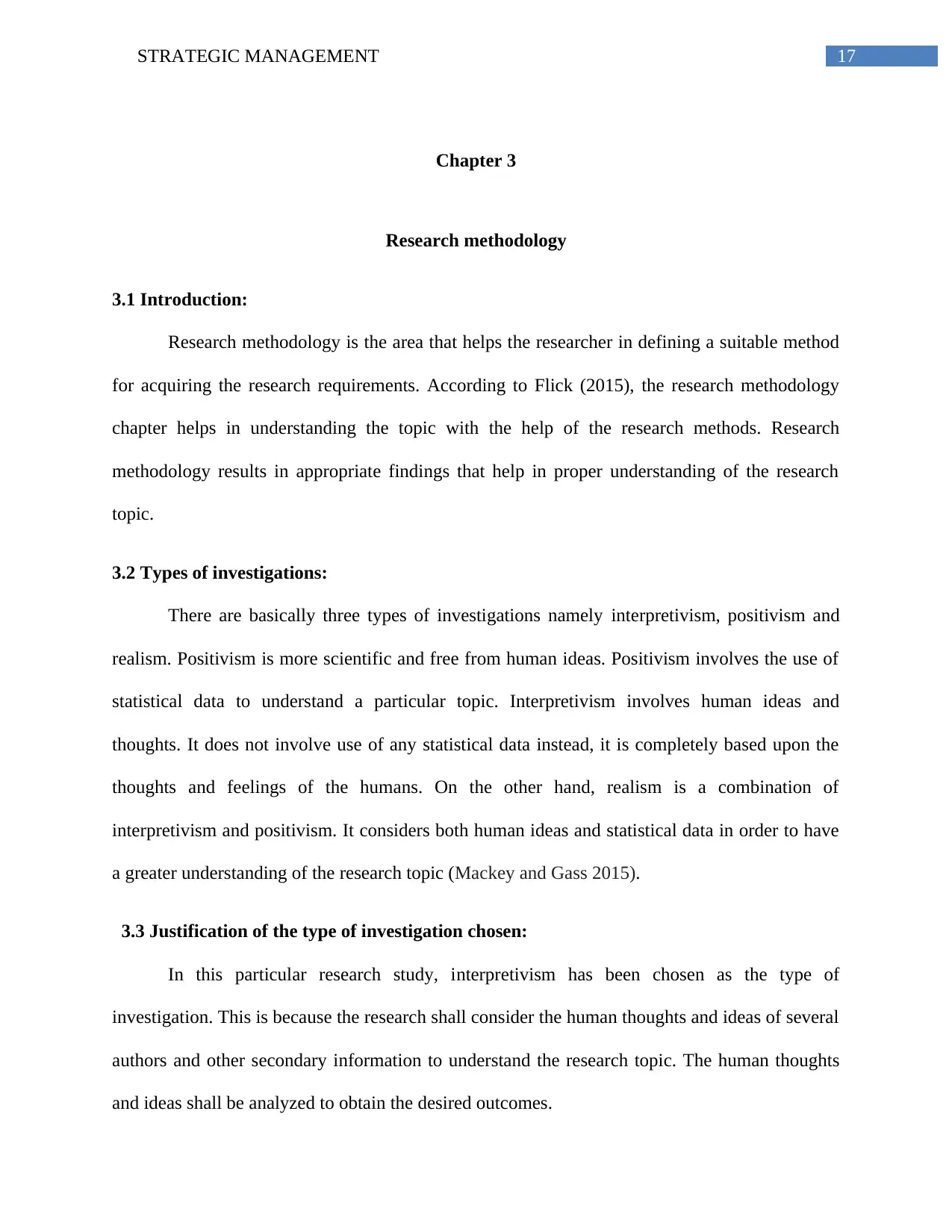
17STRATEGIC MANAGEMENT
Chapter 3
Research methodology
3.1 Introduction:
Research methodology is the area that helps the researcher in defining a suitable method
for acquiring the research requirements. According to Flick (2015), the research methodology
chapter helps in understanding the topic with the help of the research methods. Research
methodology results in appropriate findings that help in proper understanding of the research
topic.
3.2 Types of investigations:
There are basically three types of investigations namely interpretivism, positivism and
realism. Positivism is more scientific and free from human ideas. Positivism involves the use of
statistical data to understand a particular topic. Interpretivism involves human ideas and
thoughts. It does not involve use of any statistical data instead, it is completely based upon the
thoughts and feelings of the humans. On the other hand, realism is a combination of
interpretivism and positivism. It considers both human ideas and statistical data in order to have
a greater understanding of the research topic (Mackey and Gass 2015).
3.3 Justification of the type of investigation chosen:
In this particular research study, interpretivism has been chosen as the type of
investigation. This is because the research shall consider the human thoughts and ideas of several
authors and other secondary information to understand the research topic. The human thoughts
and ideas shall be analyzed to obtain the desired outcomes.
Chapter 3
Research methodology
3.1 Introduction:
Research methodology is the area that helps the researcher in defining a suitable method
for acquiring the research requirements. According to Flick (2015), the research methodology
chapter helps in understanding the topic with the help of the research methods. Research
methodology results in appropriate findings that help in proper understanding of the research
topic.
3.2 Types of investigations:
There are basically three types of investigations namely interpretivism, positivism and
realism. Positivism is more scientific and free from human ideas. Positivism involves the use of
statistical data to understand a particular topic. Interpretivism involves human ideas and
thoughts. It does not involve use of any statistical data instead, it is completely based upon the
thoughts and feelings of the humans. On the other hand, realism is a combination of
interpretivism and positivism. It considers both human ideas and statistical data in order to have
a greater understanding of the research topic (Mackey and Gass 2015).
3.3 Justification of the type of investigation chosen:
In this particular research study, interpretivism has been chosen as the type of
investigation. This is because the research shall consider the human thoughts and ideas of several
authors and other secondary information to understand the research topic. The human thoughts
and ideas shall be analyzed to obtain the desired outcomes.
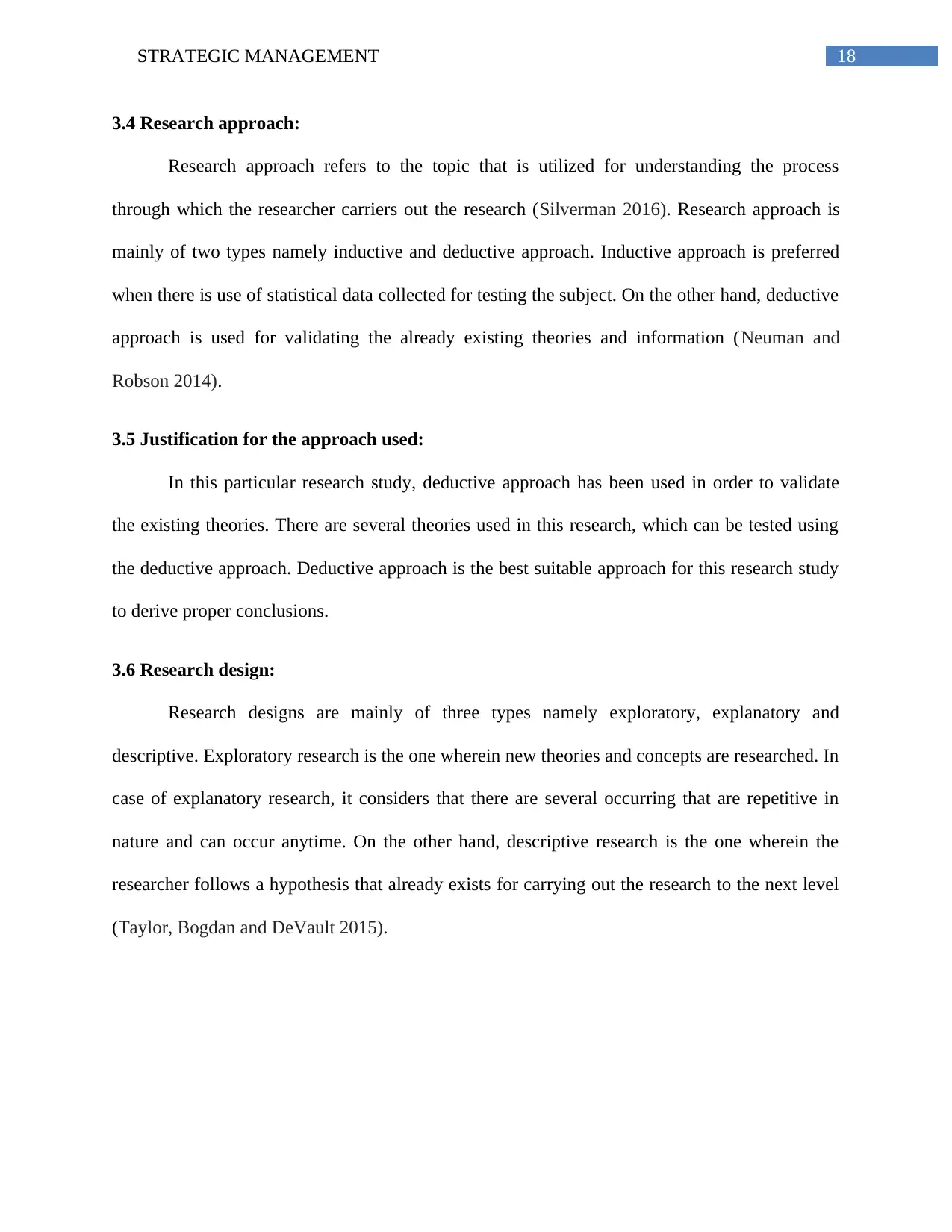
18STRATEGIC MANAGEMENT
3.4 Research approach:
Research approach refers to the topic that is utilized for understanding the process
through which the researcher carriers out the research (Silverman 2016). Research approach is
mainly of two types namely inductive and deductive approach. Inductive approach is preferred
when there is use of statistical data collected for testing the subject. On the other hand, deductive
approach is used for validating the already existing theories and information (Neuman and
Robson 2014).
3.5 Justification for the approach used:
In this particular research study, deductive approach has been used in order to validate
the existing theories. There are several theories used in this research, which can be tested using
the deductive approach. Deductive approach is the best suitable approach for this research study
to derive proper conclusions.
3.6 Research design:
Research designs are mainly of three types namely exploratory, explanatory and
descriptive. Exploratory research is the one wherein new theories and concepts are researched. In
case of explanatory research, it considers that there are several occurring that are repetitive in
nature and can occur anytime. On the other hand, descriptive research is the one wherein the
researcher follows a hypothesis that already exists for carrying out the research to the next level
(Taylor, Bogdan and DeVault 2015).
3.4 Research approach:
Research approach refers to the topic that is utilized for understanding the process
through which the researcher carriers out the research (Silverman 2016). Research approach is
mainly of two types namely inductive and deductive approach. Inductive approach is preferred
when there is use of statistical data collected for testing the subject. On the other hand, deductive
approach is used for validating the already existing theories and information (Neuman and
Robson 2014).
3.5 Justification for the approach used:
In this particular research study, deductive approach has been used in order to validate
the existing theories. There are several theories used in this research, which can be tested using
the deductive approach. Deductive approach is the best suitable approach for this research study
to derive proper conclusions.
3.6 Research design:
Research designs are mainly of three types namely exploratory, explanatory and
descriptive. Exploratory research is the one wherein new theories and concepts are researched. In
case of explanatory research, it considers that there are several occurring that are repetitive in
nature and can occur anytime. On the other hand, descriptive research is the one wherein the
researcher follows a hypothesis that already exists for carrying out the research to the next level
(Taylor, Bogdan and DeVault 2015).
Paraphrase This Document
Need a fresh take? Get an instant paraphrase of this document with our AI Paraphraser
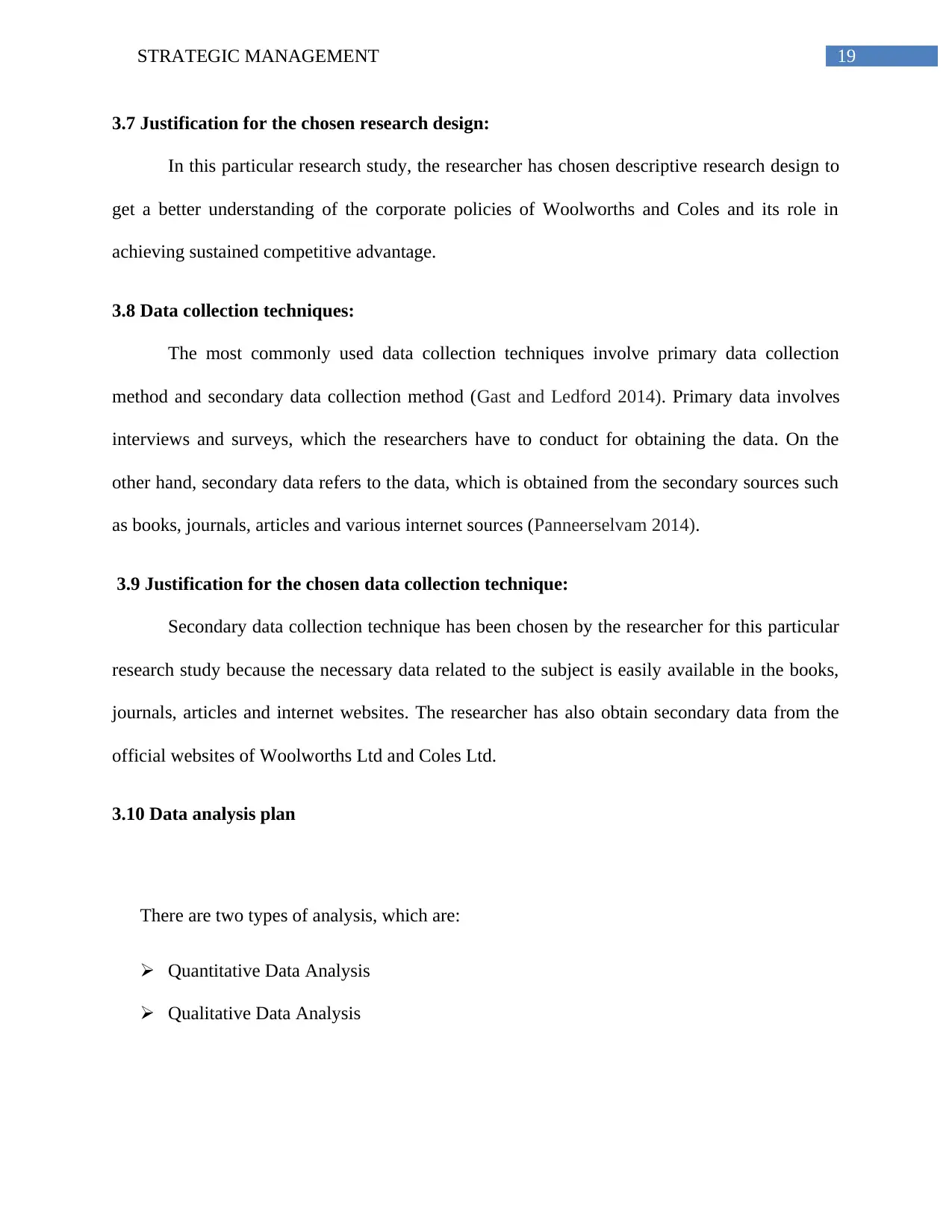
19STRATEGIC MANAGEMENT
3.7 Justification for the chosen research design:
In this particular research study, the researcher has chosen descriptive research design to
get a better understanding of the corporate policies of Woolworths and Coles and its role in
achieving sustained competitive advantage.
3.8 Data collection techniques:
The most commonly used data collection techniques involve primary data collection
method and secondary data collection method (Gast and Ledford 2014). Primary data involves
interviews and surveys, which the researchers have to conduct for obtaining the data. On the
other hand, secondary data refers to the data, which is obtained from the secondary sources such
as books, journals, articles and various internet sources (Panneerselvam 2014).
3.9 Justification for the chosen data collection technique:
Secondary data collection technique has been chosen by the researcher for this particular
research study because the necessary data related to the subject is easily available in the books,
journals, articles and internet websites. The researcher has also obtain secondary data from the
official websites of Woolworths Ltd and Coles Ltd.
3.10 Data analysis plan
There are two types of analysis, which are:
Quantitative Data Analysis
Qualitative Data Analysis
3.7 Justification for the chosen research design:
In this particular research study, the researcher has chosen descriptive research design to
get a better understanding of the corporate policies of Woolworths and Coles and its role in
achieving sustained competitive advantage.
3.8 Data collection techniques:
The most commonly used data collection techniques involve primary data collection
method and secondary data collection method (Gast and Ledford 2014). Primary data involves
interviews and surveys, which the researchers have to conduct for obtaining the data. On the
other hand, secondary data refers to the data, which is obtained from the secondary sources such
as books, journals, articles and various internet sources (Panneerselvam 2014).
3.9 Justification for the chosen data collection technique:
Secondary data collection technique has been chosen by the researcher for this particular
research study because the necessary data related to the subject is easily available in the books,
journals, articles and internet websites. The researcher has also obtain secondary data from the
official websites of Woolworths Ltd and Coles Ltd.
3.10 Data analysis plan
There are two types of analysis, which are:
Quantitative Data Analysis
Qualitative Data Analysis
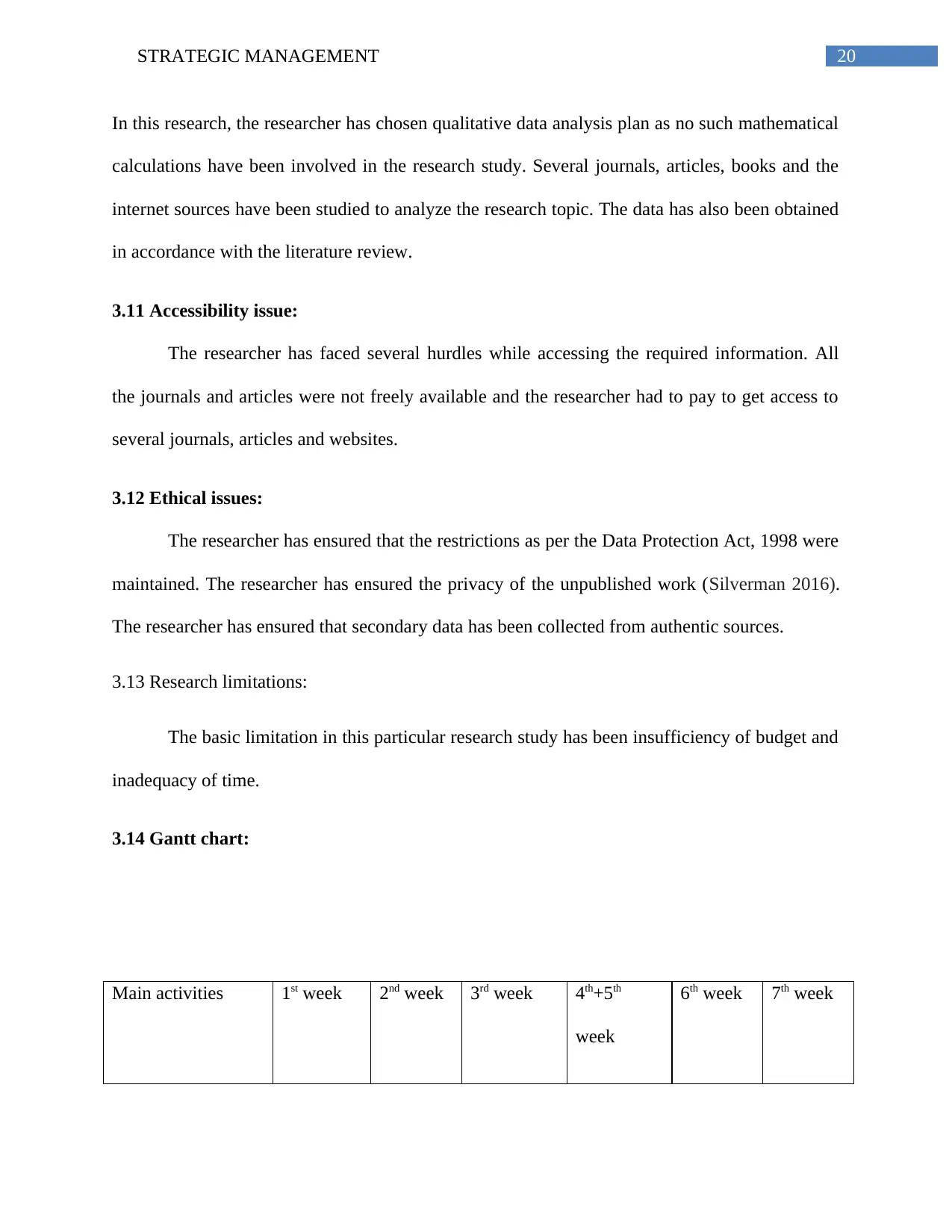
20STRATEGIC MANAGEMENT
In this research, the researcher has chosen qualitative data analysis plan as no such mathematical
calculations have been involved in the research study. Several journals, articles, books and the
internet sources have been studied to analyze the research topic. The data has also been obtained
in accordance with the literature review.
3.11 Accessibility issue:
The researcher has faced several hurdles while accessing the required information. All
the journals and articles were not freely available and the researcher had to pay to get access to
several journals, articles and websites.
3.12 Ethical issues:
The researcher has ensured that the restrictions as per the Data Protection Act, 1998 were
maintained. The researcher has ensured the privacy of the unpublished work (Silverman 2016).
The researcher has ensured that secondary data has been collected from authentic sources.
3.13 Research limitations:
The basic limitation in this particular research study has been insufficiency of budget and
inadequacy of time.
3.14 Gantt chart:
Main activities 1st week 2nd week 3rd week 4th+5th
week
6th week 7th week
In this research, the researcher has chosen qualitative data analysis plan as no such mathematical
calculations have been involved in the research study. Several journals, articles, books and the
internet sources have been studied to analyze the research topic. The data has also been obtained
in accordance with the literature review.
3.11 Accessibility issue:
The researcher has faced several hurdles while accessing the required information. All
the journals and articles were not freely available and the researcher had to pay to get access to
several journals, articles and websites.
3.12 Ethical issues:
The researcher has ensured that the restrictions as per the Data Protection Act, 1998 were
maintained. The researcher has ensured the privacy of the unpublished work (Silverman 2016).
The researcher has ensured that secondary data has been collected from authentic sources.
3.13 Research limitations:
The basic limitation in this particular research study has been insufficiency of budget and
inadequacy of time.
3.14 Gantt chart:
Main activities 1st week 2nd week 3rd week 4th+5th
week
6th week 7th week
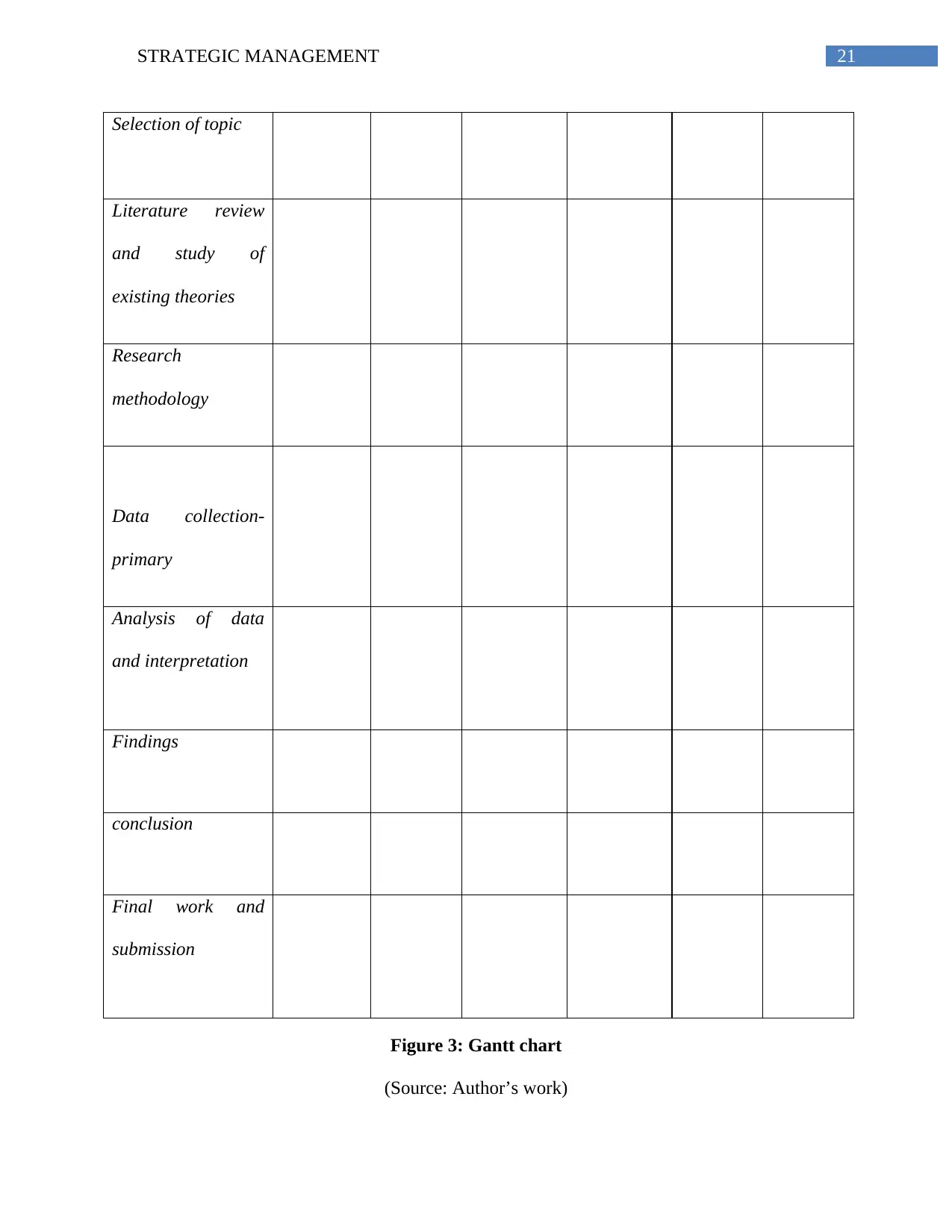
21STRATEGIC MANAGEMENT
Selection of topic
Literature review
and study of
existing theories
Research
methodology
Data collection-
primary
Analysis of data
and interpretation
Findings
conclusion
Final work and
submission
Figure 3: Gantt chart
(Source: Author’s work)
Selection of topic
Literature review
and study of
existing theories
Research
methodology
Data collection-
primary
Analysis of data
and interpretation
Findings
conclusion
Final work and
submission
Figure 3: Gantt chart
(Source: Author’s work)
Secure Best Marks with AI Grader
Need help grading? Try our AI Grader for instant feedback on your assignments.

22STRATEGIC MANAGEMENT
3.15 Summary
This chapter mentioned the research methodology adopted by the researcher for
conducting the research study. The data collection method and the type of investigation chosen
by the researcher has been mentioned in this chapter. The accessibility issues and the research
limitations faced by the researcher have also been mentioned in this chapter.
3.15 Summary
This chapter mentioned the research methodology adopted by the researcher for
conducting the research study. The data collection method and the type of investigation chosen
by the researcher has been mentioned in this chapter. The accessibility issues and the research
limitations faced by the researcher have also been mentioned in this chapter.
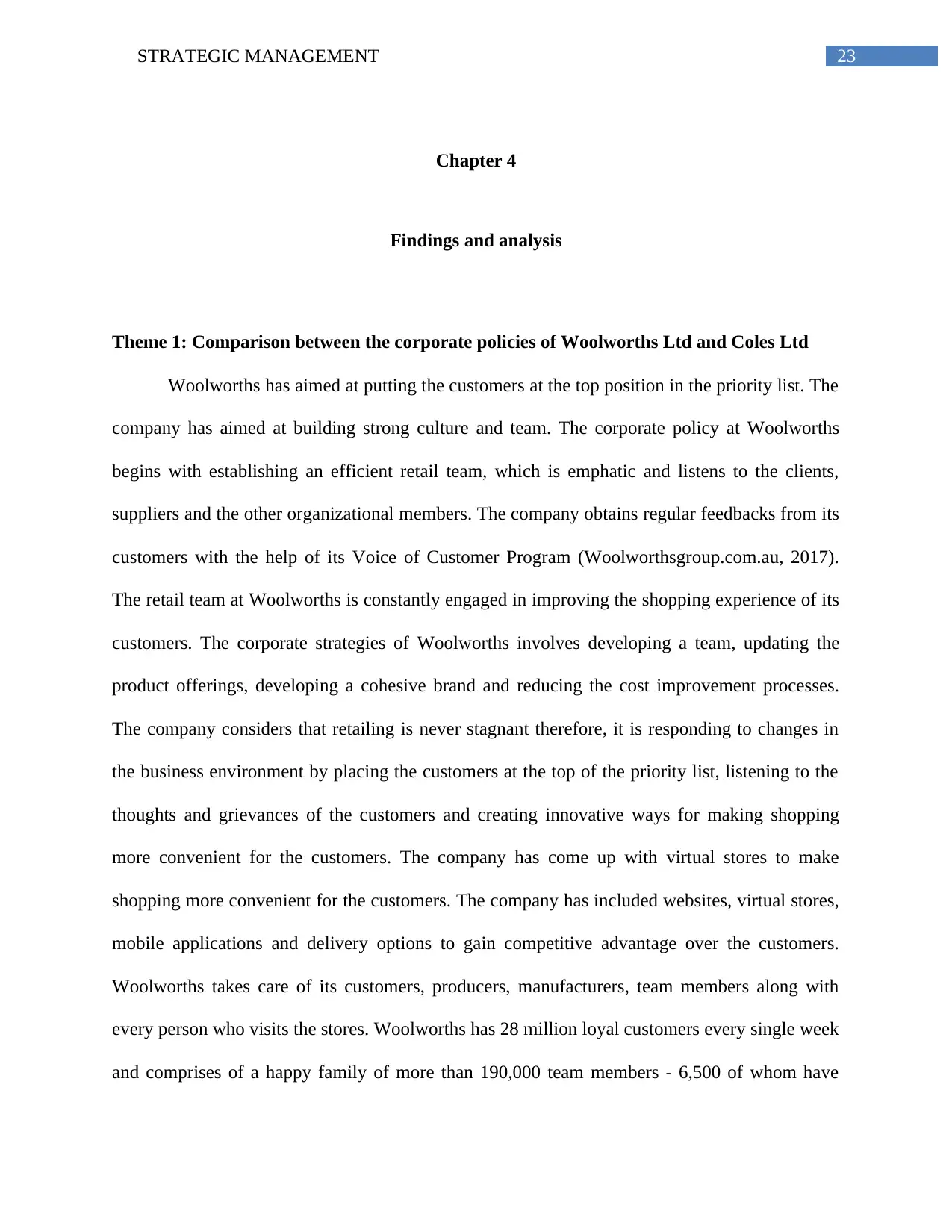
23STRATEGIC MANAGEMENT
Chapter 4
Findings and analysis
Theme 1: Comparison between the corporate policies of Woolworths Ltd and Coles Ltd
Woolworths has aimed at putting the customers at the top position in the priority list. The
company has aimed at building strong culture and team. The corporate policy at Woolworths
begins with establishing an efficient retail team, which is emphatic and listens to the clients,
suppliers and the other organizational members. The company obtains regular feedbacks from its
customers with the help of its Voice of Customer Program (Woolworthsgroup.com.au, 2017).
The retail team at Woolworths is constantly engaged in improving the shopping experience of its
customers. The corporate strategies of Woolworths involves developing a team, updating the
product offerings, developing a cohesive brand and reducing the cost improvement processes.
The company considers that retailing is never stagnant therefore, it is responding to changes in
the business environment by placing the customers at the top of the priority list, listening to the
thoughts and grievances of the customers and creating innovative ways for making shopping
more convenient for the customers. The company has come up with virtual stores to make
shopping more convenient for the customers. The company has included websites, virtual stores,
mobile applications and delivery options to gain competitive advantage over the customers.
Woolworths takes care of its customers, producers, manufacturers, team members along with
every person who visits the stores. Woolworths has 28 million loyal customers every single week
and comprises of a happy family of more than 190,000 team members - 6,500 of whom have
Chapter 4
Findings and analysis
Theme 1: Comparison between the corporate policies of Woolworths Ltd and Coles Ltd
Woolworths has aimed at putting the customers at the top position in the priority list. The
company has aimed at building strong culture and team. The corporate policy at Woolworths
begins with establishing an efficient retail team, which is emphatic and listens to the clients,
suppliers and the other organizational members. The company obtains regular feedbacks from its
customers with the help of its Voice of Customer Program (Woolworthsgroup.com.au, 2017).
The retail team at Woolworths is constantly engaged in improving the shopping experience of its
customers. The corporate strategies of Woolworths involves developing a team, updating the
product offerings, developing a cohesive brand and reducing the cost improvement processes.
The company considers that retailing is never stagnant therefore, it is responding to changes in
the business environment by placing the customers at the top of the priority list, listening to the
thoughts and grievances of the customers and creating innovative ways for making shopping
more convenient for the customers. The company has come up with virtual stores to make
shopping more convenient for the customers. The company has included websites, virtual stores,
mobile applications and delivery options to gain competitive advantage over the customers.
Woolworths takes care of its customers, producers, manufacturers, team members along with
every person who visits the stores. Woolworths has 28 million loyal customers every single week
and comprises of a happy family of more than 190,000 team members - 6,500 of whom have
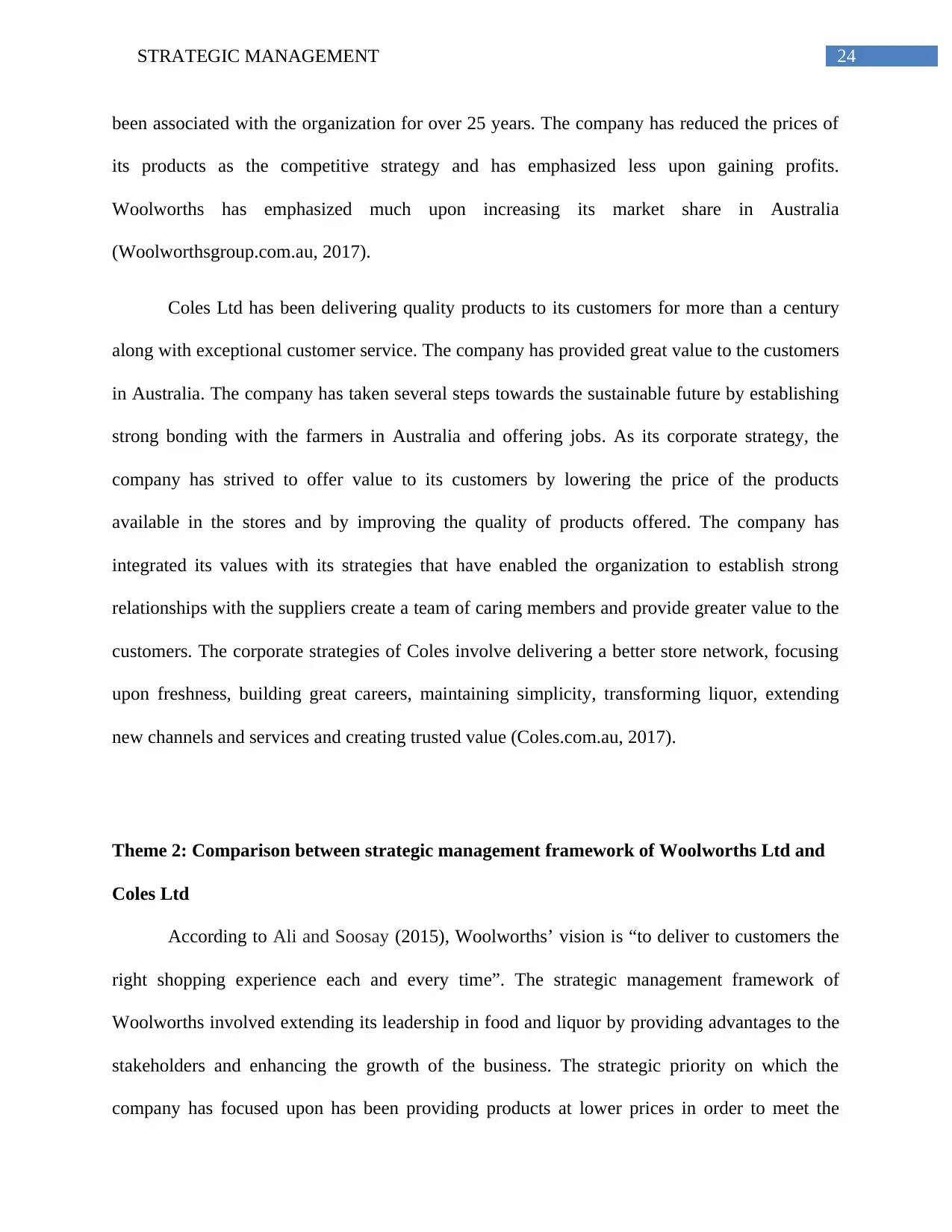
24STRATEGIC MANAGEMENT
been associated with the organization for over 25 years. The company has reduced the prices of
its products as the competitive strategy and has emphasized less upon gaining profits.
Woolworths has emphasized much upon increasing its market share in Australia
(Woolworthsgroup.com.au, 2017).
Coles Ltd has been delivering quality products to its customers for more than a century
along with exceptional customer service. The company has provided great value to the customers
in Australia. The company has taken several steps towards the sustainable future by establishing
strong bonding with the farmers in Australia and offering jobs. As its corporate strategy, the
company has strived to offer value to its customers by lowering the price of the products
available in the stores and by improving the quality of products offered. The company has
integrated its values with its strategies that have enabled the organization to establish strong
relationships with the suppliers create a team of caring members and provide greater value to the
customers. The corporate strategies of Coles involve delivering a better store network, focusing
upon freshness, building great careers, maintaining simplicity, transforming liquor, extending
new channels and services and creating trusted value (Coles.com.au, 2017).
Theme 2: Comparison between strategic management framework of Woolworths Ltd and
Coles Ltd
According to Ali and Soosay (2015), Woolworths’ vision is “to deliver to customers the
right shopping experience each and every time”. The strategic management framework of
Woolworths involved extending its leadership in food and liquor by providing advantages to the
stakeholders and enhancing the growth of the business. The strategic priority on which the
company has focused upon has been providing products at lower prices in order to meet the
been associated with the organization for over 25 years. The company has reduced the prices of
its products as the competitive strategy and has emphasized less upon gaining profits.
Woolworths has emphasized much upon increasing its market share in Australia
(Woolworthsgroup.com.au, 2017).
Coles Ltd has been delivering quality products to its customers for more than a century
along with exceptional customer service. The company has provided great value to the customers
in Australia. The company has taken several steps towards the sustainable future by establishing
strong bonding with the farmers in Australia and offering jobs. As its corporate strategy, the
company has strived to offer value to its customers by lowering the price of the products
available in the stores and by improving the quality of products offered. The company has
integrated its values with its strategies that have enabled the organization to establish strong
relationships with the suppliers create a team of caring members and provide greater value to the
customers. The corporate strategies of Coles involve delivering a better store network, focusing
upon freshness, building great careers, maintaining simplicity, transforming liquor, extending
new channels and services and creating trusted value (Coles.com.au, 2017).
Theme 2: Comparison between strategic management framework of Woolworths Ltd and
Coles Ltd
According to Ali and Soosay (2015), Woolworths’ vision is “to deliver to customers the
right shopping experience each and every time”. The strategic management framework of
Woolworths involved extending its leadership in food and liquor by providing advantages to the
stakeholders and enhancing the growth of the business. The strategic priority on which the
company has focused upon has been providing products at lower prices in order to meet the
Paraphrase This Document
Need a fresh take? Get an instant paraphrase of this document with our AI Paraphraser

25STRATEGIC MANAGEMENT
expectations of the customers. The company has also emphasized upon maximizing the the
shareholder value through enhanced marketing. The company has a strong portfolio, which it has
maintained since years. The company has additionally emphasized upon creating unique,
sustainable and profitable improvement. According to Turner and Mortimer (2014), Woolworths
is not much dependent upon its suppliers that has resulted in the weak bargaining power of the
suppliers. The customers of Woolworths have strong bargaining power that has encouraged the
company to keep its product prices minimal. Woolworths does not face any threat from new
entrants as it is not easy for a new company to set up a large number of stores and offer quality
products at low prices. The company faces threat from substitutes therefore, the company often
comes up with innovative ideas for attracting the customers. There is a strong rivalry among the
competitors majorly Coles and Aldi (Woolworthsgroup.com.au, 2017).
According to Mortimer (2016), Coles has been a famous super market in Australia but
the organization has faced certain issues in the recent times pertaining to the reduction in the
brand reputation, which has indirectly led to the reduction in the annual sales revenue of the
company. In order to sustain in the highly competitive environment, Coles emphasized upon its
pricing strategy for attracting the customers. The organization lowered its product prices in order
to increase its sales. The organization emphasized upon the feedback obtained from the
customers to improve its products and services. The market analysis strategy helped the
organization in identifying the major competitors and the strategies adopted by them to attract
the customers. The organization promoted its brand among the target clients to retain them and
increase the number of loyal customers (Coles.com.au, 2017).
expectations of the customers. The company has also emphasized upon maximizing the the
shareholder value through enhanced marketing. The company has a strong portfolio, which it has
maintained since years. The company has additionally emphasized upon creating unique,
sustainable and profitable improvement. According to Turner and Mortimer (2014), Woolworths
is not much dependent upon its suppliers that has resulted in the weak bargaining power of the
suppliers. The customers of Woolworths have strong bargaining power that has encouraged the
company to keep its product prices minimal. Woolworths does not face any threat from new
entrants as it is not easy for a new company to set up a large number of stores and offer quality
products at low prices. The company faces threat from substitutes therefore, the company often
comes up with innovative ideas for attracting the customers. There is a strong rivalry among the
competitors majorly Coles and Aldi (Woolworthsgroup.com.au, 2017).
According to Mortimer (2016), Coles has been a famous super market in Australia but
the organization has faced certain issues in the recent times pertaining to the reduction in the
brand reputation, which has indirectly led to the reduction in the annual sales revenue of the
company. In order to sustain in the highly competitive environment, Coles emphasized upon its
pricing strategy for attracting the customers. The organization lowered its product prices in order
to increase its sales. The organization emphasized upon the feedback obtained from the
customers to improve its products and services. The market analysis strategy helped the
organization in identifying the major competitors and the strategies adopted by them to attract
the customers. The organization promoted its brand among the target clients to retain them and
increase the number of loyal customers (Coles.com.au, 2017).
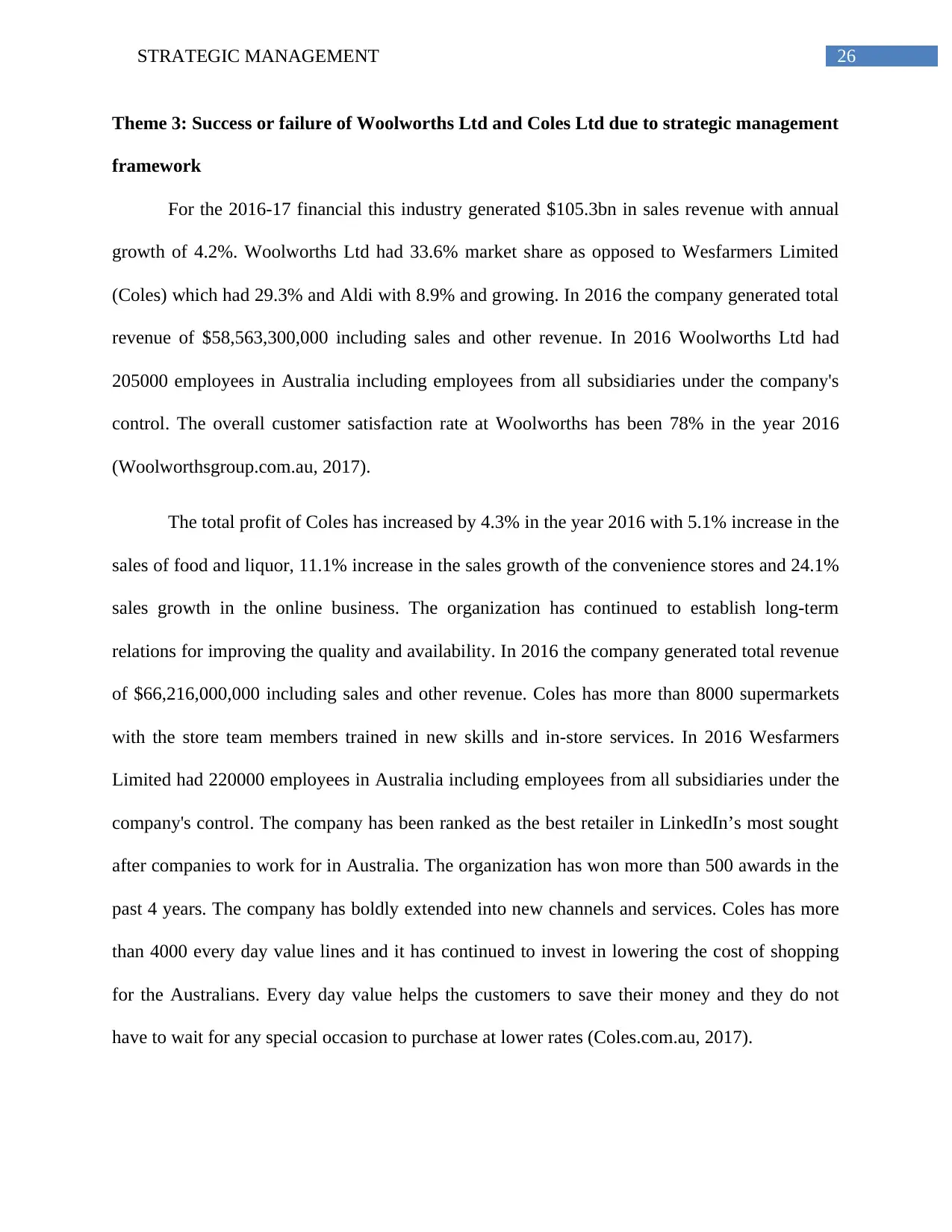
26STRATEGIC MANAGEMENT
Theme 3: Success or failure of Woolworths Ltd and Coles Ltd due to strategic management
framework
For the 2016-17 financial this industry generated $105.3bn in sales revenue with annual
growth of 4.2%. Woolworths Ltd had 33.6% market share as opposed to Wesfarmers Limited
(Coles) which had 29.3% and Aldi with 8.9% and growing. In 2016 the company generated total
revenue of $58,563,300,000 including sales and other revenue. In 2016 Woolworths Ltd had
205000 employees in Australia including employees from all subsidiaries under the company's
control. The overall customer satisfaction rate at Woolworths has been 78% in the year 2016
(Woolworthsgroup.com.au, 2017).
The total profit of Coles has increased by 4.3% in the year 2016 with 5.1% increase in the
sales of food and liquor, 11.1% increase in the sales growth of the convenience stores and 24.1%
sales growth in the online business. The organization has continued to establish long-term
relations for improving the quality and availability. In 2016 the company generated total revenue
of $66,216,000,000 including sales and other revenue. Coles has more than 8000 supermarkets
with the store team members trained in new skills and in-store services. In 2016 Wesfarmers
Limited had 220000 employees in Australia including employees from all subsidiaries under the
company's control. The company has been ranked as the best retailer in LinkedIn’s most sought
after companies to work for in Australia. The organization has won more than 500 awards in the
past 4 years. The company has boldly extended into new channels and services. Coles has more
than 4000 every day value lines and it has continued to invest in lowering the cost of shopping
for the Australians. Every day value helps the customers to save their money and they do not
have to wait for any special occasion to purchase at lower rates (Coles.com.au, 2017).
Theme 3: Success or failure of Woolworths Ltd and Coles Ltd due to strategic management
framework
For the 2016-17 financial this industry generated $105.3bn in sales revenue with annual
growth of 4.2%. Woolworths Ltd had 33.6% market share as opposed to Wesfarmers Limited
(Coles) which had 29.3% and Aldi with 8.9% and growing. In 2016 the company generated total
revenue of $58,563,300,000 including sales and other revenue. In 2016 Woolworths Ltd had
205000 employees in Australia including employees from all subsidiaries under the company's
control. The overall customer satisfaction rate at Woolworths has been 78% in the year 2016
(Woolworthsgroup.com.au, 2017).
The total profit of Coles has increased by 4.3% in the year 2016 with 5.1% increase in the
sales of food and liquor, 11.1% increase in the sales growth of the convenience stores and 24.1%
sales growth in the online business. The organization has continued to establish long-term
relations for improving the quality and availability. In 2016 the company generated total revenue
of $66,216,000,000 including sales and other revenue. Coles has more than 8000 supermarkets
with the store team members trained in new skills and in-store services. In 2016 Wesfarmers
Limited had 220000 employees in Australia including employees from all subsidiaries under the
company's control. The company has been ranked as the best retailer in LinkedIn’s most sought
after companies to work for in Australia. The organization has won more than 500 awards in the
past 4 years. The company has boldly extended into new channels and services. Coles has more
than 4000 every day value lines and it has continued to invest in lowering the cost of shopping
for the Australians. Every day value helps the customers to save their money and they do not
have to wait for any special occasion to purchase at lower rates (Coles.com.au, 2017).
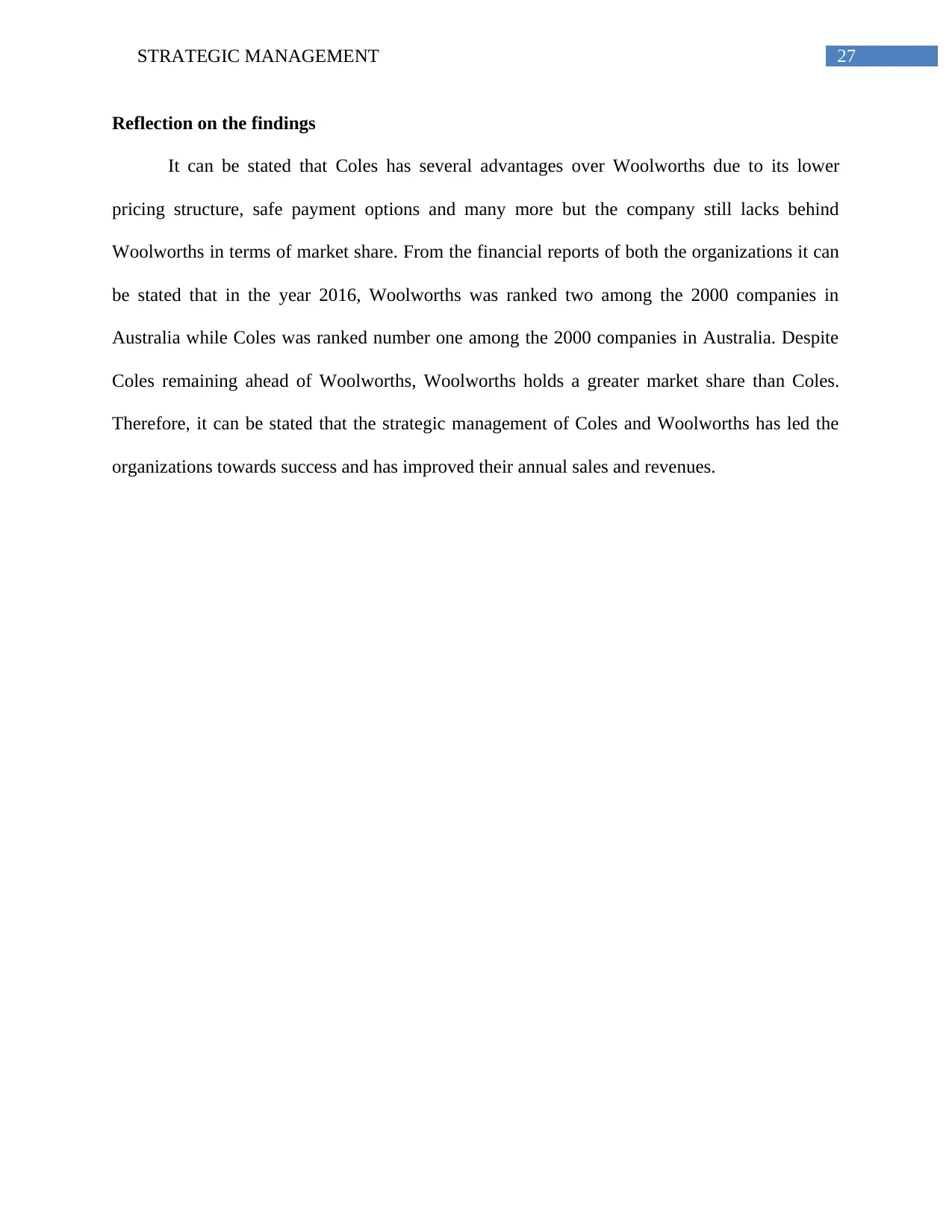
27STRATEGIC MANAGEMENT
Reflection on the findings
It can be stated that Coles has several advantages over Woolworths due to its lower
pricing structure, safe payment options and many more but the company still lacks behind
Woolworths in terms of market share. From the financial reports of both the organizations it can
be stated that in the year 2016, Woolworths was ranked two among the 2000 companies in
Australia while Coles was ranked number one among the 2000 companies in Australia. Despite
Coles remaining ahead of Woolworths, Woolworths holds a greater market share than Coles.
Therefore, it can be stated that the strategic management of Coles and Woolworths has led the
organizations towards success and has improved their annual sales and revenues.
Reflection on the findings
It can be stated that Coles has several advantages over Woolworths due to its lower
pricing structure, safe payment options and many more but the company still lacks behind
Woolworths in terms of market share. From the financial reports of both the organizations it can
be stated that in the year 2016, Woolworths was ranked two among the 2000 companies in
Australia while Coles was ranked number one among the 2000 companies in Australia. Despite
Coles remaining ahead of Woolworths, Woolworths holds a greater market share than Coles.
Therefore, it can be stated that the strategic management of Coles and Woolworths has led the
organizations towards success and has improved their annual sales and revenues.
Secure Best Marks with AI Grader
Need help grading? Try our AI Grader for instant feedback on your assignments.
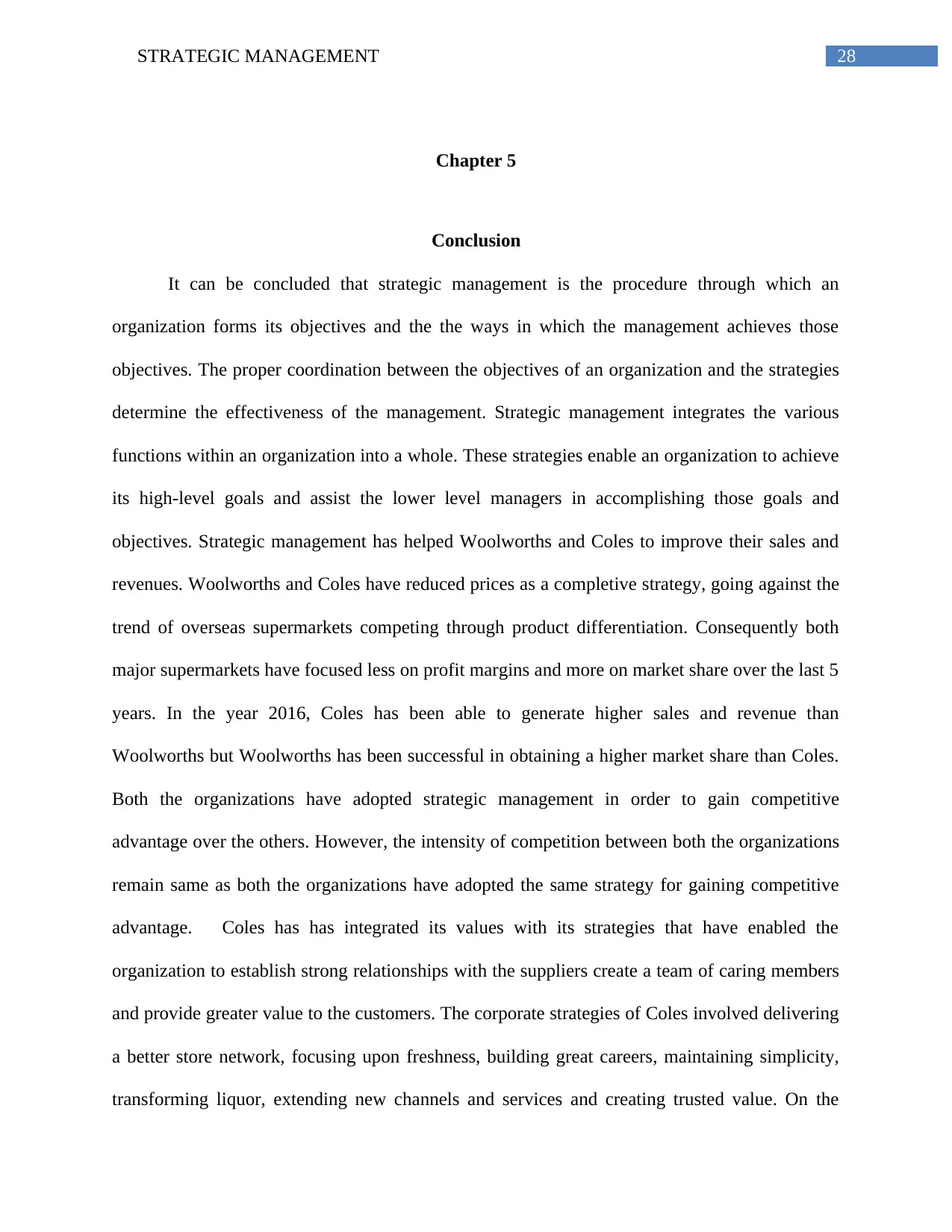
28STRATEGIC MANAGEMENT
Chapter 5
Conclusion
It can be concluded that strategic management is the procedure through which an
organization forms its objectives and the the ways in which the management achieves those
objectives. The proper coordination between the objectives of an organization and the strategies
determine the effectiveness of the management. Strategic management integrates the various
functions within an organization into a whole. These strategies enable an organization to achieve
its high-level goals and assist the lower level managers in accomplishing those goals and
objectives. Strategic management has helped Woolworths and Coles to improve their sales and
revenues. Woolworths and Coles have reduced prices as a completive strategy, going against the
trend of overseas supermarkets competing through product differentiation. Consequently both
major supermarkets have focused less on profit margins and more on market share over the last 5
years. In the year 2016, Coles has been able to generate higher sales and revenue than
Woolworths but Woolworths has been successful in obtaining a higher market share than Coles.
Both the organizations have adopted strategic management in order to gain competitive
advantage over the others. However, the intensity of competition between both the organizations
remain same as both the organizations have adopted the same strategy for gaining competitive
advantage. Coles has has integrated its values with its strategies that have enabled the
organization to establish strong relationships with the suppliers create a team of caring members
and provide greater value to the customers. The corporate strategies of Coles involved delivering
a better store network, focusing upon freshness, building great careers, maintaining simplicity,
transforming liquor, extending new channels and services and creating trusted value. On the
Chapter 5
Conclusion
It can be concluded that strategic management is the procedure through which an
organization forms its objectives and the the ways in which the management achieves those
objectives. The proper coordination between the objectives of an organization and the strategies
determine the effectiveness of the management. Strategic management integrates the various
functions within an organization into a whole. These strategies enable an organization to achieve
its high-level goals and assist the lower level managers in accomplishing those goals and
objectives. Strategic management has helped Woolworths and Coles to improve their sales and
revenues. Woolworths and Coles have reduced prices as a completive strategy, going against the
trend of overseas supermarkets competing through product differentiation. Consequently both
major supermarkets have focused less on profit margins and more on market share over the last 5
years. In the year 2016, Coles has been able to generate higher sales and revenue than
Woolworths but Woolworths has been successful in obtaining a higher market share than Coles.
Both the organizations have adopted strategic management in order to gain competitive
advantage over the others. However, the intensity of competition between both the organizations
remain same as both the organizations have adopted the same strategy for gaining competitive
advantage. Coles has has integrated its values with its strategies that have enabled the
organization to establish strong relationships with the suppliers create a team of caring members
and provide greater value to the customers. The corporate strategies of Coles involved delivering
a better store network, focusing upon freshness, building great careers, maintaining simplicity,
transforming liquor, extending new channels and services and creating trusted value. On the

29STRATEGIC MANAGEMENT
other hand, the corporate policy at Woolworths began with establishing an efficient retail team,
which was emphatic and listened to the clients, suppliers and the other organizational members.
The company obtained regular feedbacks from its customers with the help of its Voice of
Customer Program. The retail team at Woolworths has been constantly engaged in improving the
shopping experience of its customers.
other hand, the corporate policy at Woolworths began with establishing an efficient retail team,
which was emphatic and listened to the clients, suppliers and the other organizational members.
The company obtained regular feedbacks from its customers with the help of its Voice of
Customer Program. The retail team at Woolworths has been constantly engaged in improving the
shopping experience of its customers.
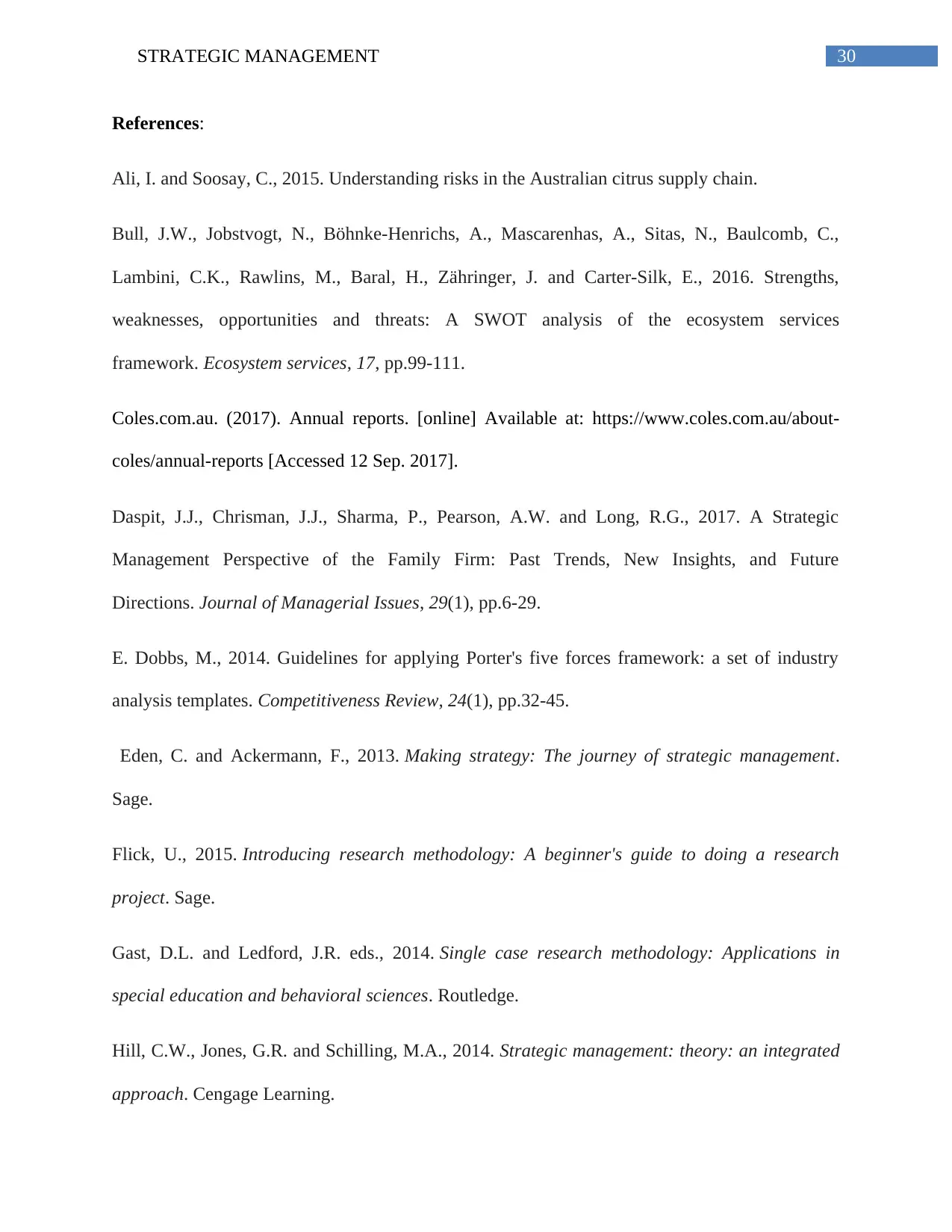
30STRATEGIC MANAGEMENT
References:
Ali, I. and Soosay, C., 2015. Understanding risks in the Australian citrus supply chain.
Bull, J.W., Jobstvogt, N., Böhnke-Henrichs, A., Mascarenhas, A., Sitas, N., Baulcomb, C.,
Lambini, C.K., Rawlins, M., Baral, H., Zähringer, J. and Carter-Silk, E., 2016. Strengths,
weaknesses, opportunities and threats: A SWOT analysis of the ecosystem services
framework. Ecosystem services, 17, pp.99-111.
Coles.com.au. (2017). Annual reports. [online] Available at: https://www.coles.com.au/about-
coles/annual-reports [Accessed 12 Sep. 2017].
Daspit, J.J., Chrisman, J.J., Sharma, P., Pearson, A.W. and Long, R.G., 2017. A Strategic
Management Perspective of the Family Firm: Past Trends, New Insights, and Future
Directions. Journal of Managerial Issues, 29(1), pp.6-29.
E. Dobbs, M., 2014. Guidelines for applying Porter's five forces framework: a set of industry
analysis templates. Competitiveness Review, 24(1), pp.32-45.
Eden, C. and Ackermann, F., 2013. Making strategy: The journey of strategic management.
Sage.
Flick, U., 2015. Introducing research methodology: A beginner's guide to doing a research
project. Sage.
Gast, D.L. and Ledford, J.R. eds., 2014. Single case research methodology: Applications in
special education and behavioral sciences. Routledge.
Hill, C.W., Jones, G.R. and Schilling, M.A., 2014. Strategic management: theory: an integrated
approach. Cengage Learning.
References:
Ali, I. and Soosay, C., 2015. Understanding risks in the Australian citrus supply chain.
Bull, J.W., Jobstvogt, N., Böhnke-Henrichs, A., Mascarenhas, A., Sitas, N., Baulcomb, C.,
Lambini, C.K., Rawlins, M., Baral, H., Zähringer, J. and Carter-Silk, E., 2016. Strengths,
weaknesses, opportunities and threats: A SWOT analysis of the ecosystem services
framework. Ecosystem services, 17, pp.99-111.
Coles.com.au. (2017). Annual reports. [online] Available at: https://www.coles.com.au/about-
coles/annual-reports [Accessed 12 Sep. 2017].
Daspit, J.J., Chrisman, J.J., Sharma, P., Pearson, A.W. and Long, R.G., 2017. A Strategic
Management Perspective of the Family Firm: Past Trends, New Insights, and Future
Directions. Journal of Managerial Issues, 29(1), pp.6-29.
E. Dobbs, M., 2014. Guidelines for applying Porter's five forces framework: a set of industry
analysis templates. Competitiveness Review, 24(1), pp.32-45.
Eden, C. and Ackermann, F., 2013. Making strategy: The journey of strategic management.
Sage.
Flick, U., 2015. Introducing research methodology: A beginner's guide to doing a research
project. Sage.
Gast, D.L. and Ledford, J.R. eds., 2014. Single case research methodology: Applications in
special education and behavioral sciences. Routledge.
Hill, C.W., Jones, G.R. and Schilling, M.A., 2014. Strategic management: theory: an integrated
approach. Cengage Learning.
Paraphrase This Document
Need a fresh take? Get an instant paraphrase of this document with our AI Paraphraser

31STRATEGIC MANAGEMENT
Ho, J.K.K., 2014. Formulation of a systemic PEST analysis for strategic analysis. European
academic research, 2(5), pp.6478-6492.
Mackey, A. and Gass, S.M., 2015. Second language research: Methodology and design.
Routledge.
Mortimer, G., 2016. ALDI gives suppliers, as well as shoppers, greater choice: Retail
expert. Journal of the Home Economics Institute of Australia, 23(2), p.39.
Neuman, W.L. and Robson, K., 2014. Basics of social research. Pearson Canada.
Panneerselvam, R., 2014. Research methodology. PHI Learning Pvt. Ltd..
Peppard, J. and Ward, J., 2016. The strategic management of information systems: Building a
digital strategy. John Wiley & Sons.
Porter, M.E. and Heppelmann, J.E., 2014. How smart, connected products are transforming
competition. Harvard Business Review, 92(11), pp.64-88.
Purce, J., 2014. The impact of corporate strategy on human resource management. New
Perspectives on Human Resource Management (Routledge Revivals), 67.
Rothaermel, F.T., 2015. Strategic management. McGraw-Hill Education.
Sigmon, B.S., 2014. Using a SWOT Analysis: Taking a Look at Your Organization.
Silverman, D. ed., 2016. Qualitative research. Sage.
Slack, N., 2015. Operations strategy. John Wiley & Sons, Ltd.
Stead, J.G. and Stead, W.E., 2013. Sustainable strategic management. ME Sharpe.
Ho, J.K.K., 2014. Formulation of a systemic PEST analysis for strategic analysis. European
academic research, 2(5), pp.6478-6492.
Mackey, A. and Gass, S.M., 2015. Second language research: Methodology and design.
Routledge.
Mortimer, G., 2016. ALDI gives suppliers, as well as shoppers, greater choice: Retail
expert. Journal of the Home Economics Institute of Australia, 23(2), p.39.
Neuman, W.L. and Robson, K., 2014. Basics of social research. Pearson Canada.
Panneerselvam, R., 2014. Research methodology. PHI Learning Pvt. Ltd..
Peppard, J. and Ward, J., 2016. The strategic management of information systems: Building a
digital strategy. John Wiley & Sons.
Porter, M.E. and Heppelmann, J.E., 2014. How smart, connected products are transforming
competition. Harvard Business Review, 92(11), pp.64-88.
Purce, J., 2014. The impact of corporate strategy on human resource management. New
Perspectives on Human Resource Management (Routledge Revivals), 67.
Rothaermel, F.T., 2015. Strategic management. McGraw-Hill Education.
Sigmon, B.S., 2014. Using a SWOT Analysis: Taking a Look at Your Organization.
Silverman, D. ed., 2016. Qualitative research. Sage.
Slack, N., 2015. Operations strategy. John Wiley & Sons, Ltd.
Stead, J.G. and Stead, W.E., 2013. Sustainable strategic management. ME Sharpe.
1 out of 32
Related Documents
Your All-in-One AI-Powered Toolkit for Academic Success.
+13062052269
info@desklib.com
Available 24*7 on WhatsApp / Email
![[object Object]](/_next/static/media/star-bottom.7253800d.svg)
Unlock your academic potential
© 2024 | Zucol Services PVT LTD | All rights reserved.




